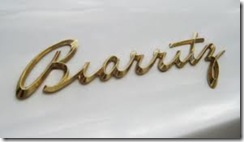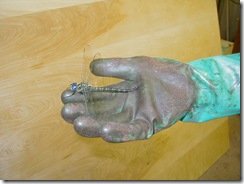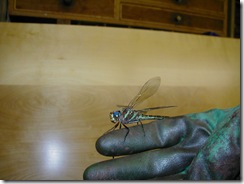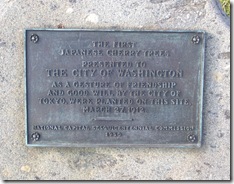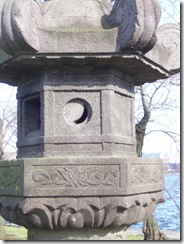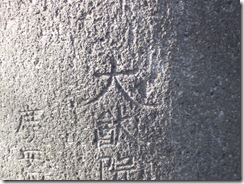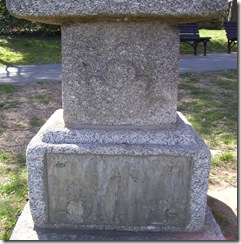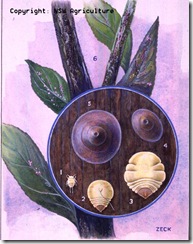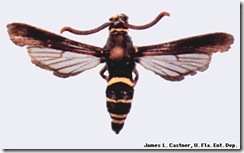March 26, 2018
'povero vecchio'
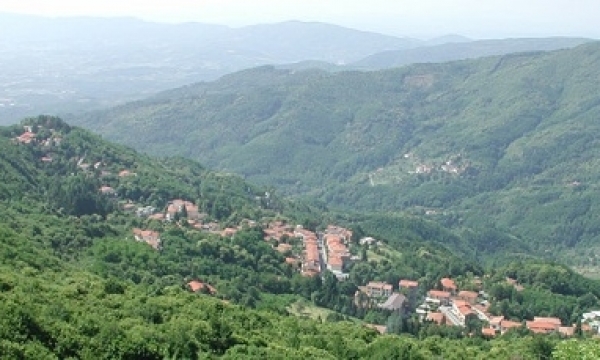 Cireglio
Cireglio
July 17, 1931 Cireglio, Italy - Adamo Paci woke up to another hot, dry day in the Tuscan Apennines overlooking the medieval city of Pistoia in the valley below. There is a drought this year, crops are weak, the economy is weak. Prime Minister Mussolini has made every thing a battle: the battle for grain, the battle for the lira, the battle for land, and the battle for births to supply a growing army.
In a mind twisting game Il Duce is trying to make Italians feel like they are joined together in a national struggle for independence so as to disguise the fact that his Facisti government is failing, and most Italians are living in unpleasant poverty compared to their neighboring countries. The letters home from those Italians who emigrated reinforce that fact, and the money they send home is a line item on the national budget.
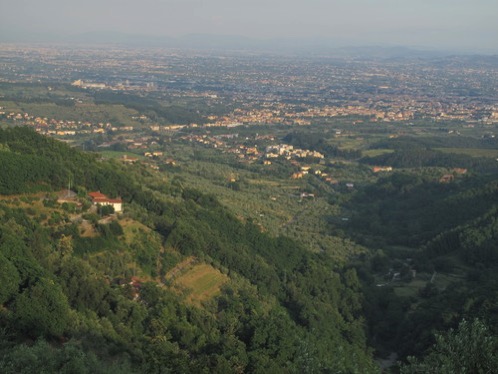 Pistoia in the valley below
Pistoia in the valley below
Our Adamo is not up for any battles, and he’s not happy. At 83, his mind is filled with the past. his wife, Argene, has been gone for two and a half years; son Giulio died in April, and daughter-in-law Clotilde Bartoli, wife of Adamo’s son Ugo, has also died this year.
This July Friday in 1931 Adamo wrote a post card to Cino Paci, one of his three sons living in Exeter, Pa. With a fair hand, he wrote 16 lines in black ink with his fountain pen revealing a regretful man, well worn down from his years.
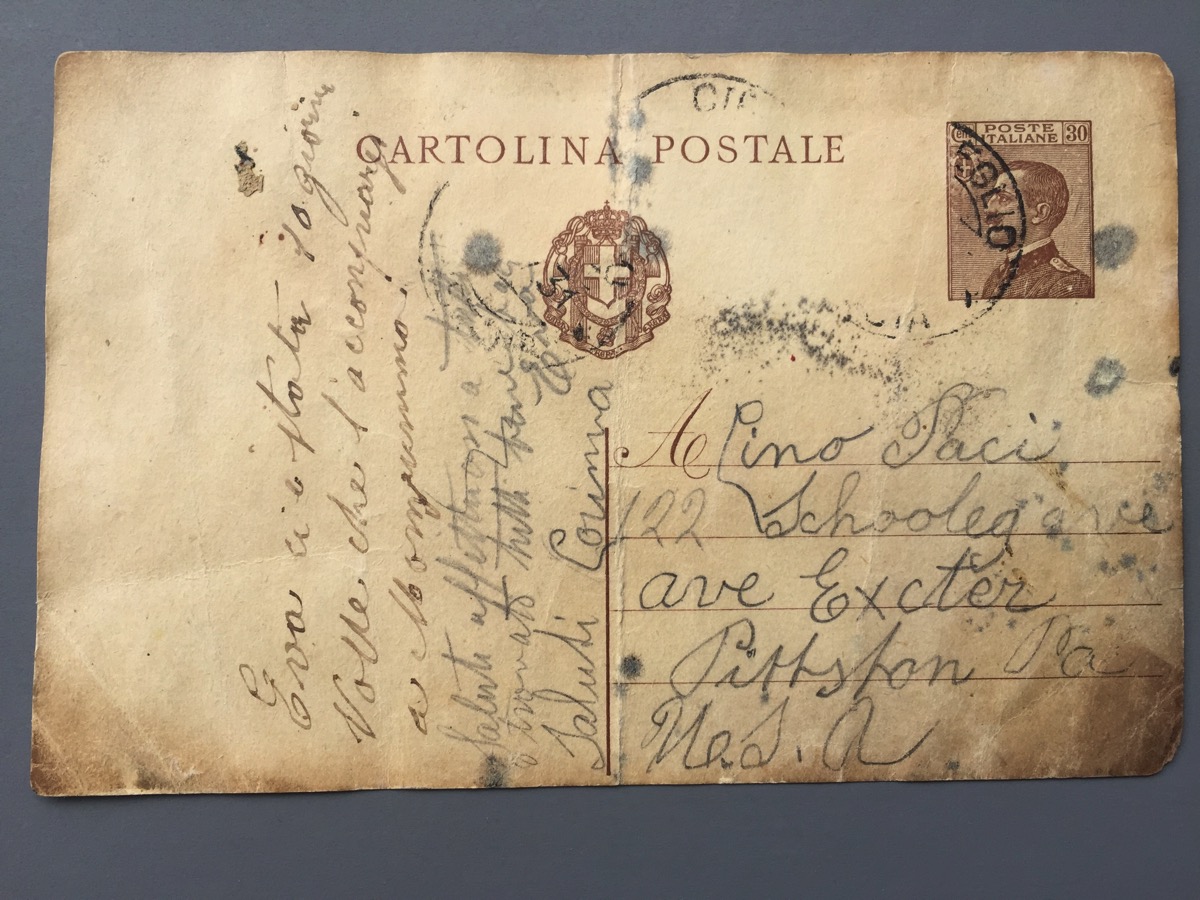
Eva and Corinna post their greetings on the front of the card
His post card was in response to a card he received from Cino, the contents of which are unknown. Maybe Cino felt like reaching out since the death of his brother Giulio in April. Whatever Cino wrote got him a verbal spanking from his father.
Adamo’s career as a tailor has long been over. We don’t really know about that part of his life in Cireglio, his small mountain village of about 500 people, most of whom had their own sewing kits and knew how to use them. We don’t know what he did day to day: Did he have a garden? Did he have chickens and rabbits? Did he have a grape arbor? We do know from a previous letter he was a drinker. I wish I knew what he was drinking.
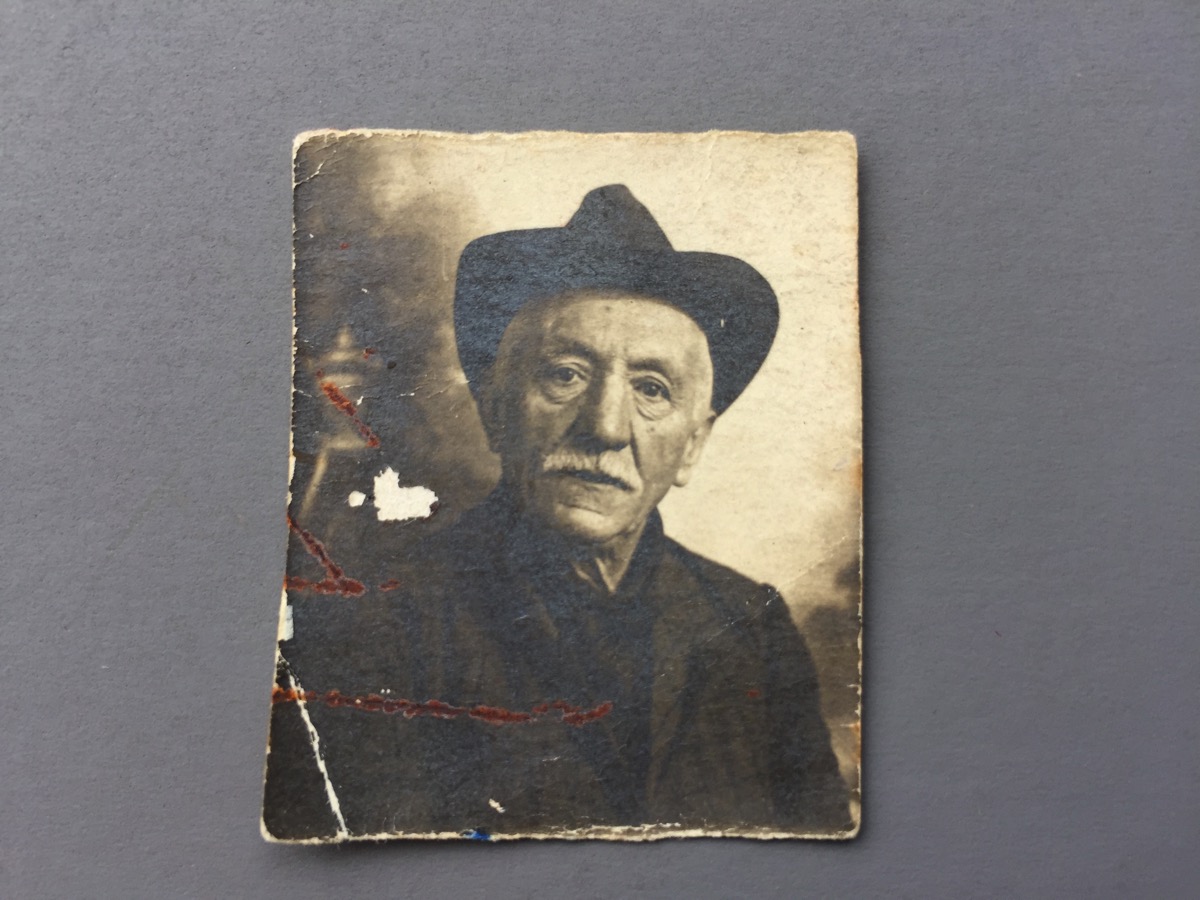
il ‘sfortunato' padre Adamo
He may be thinking life has passed him by, but he’s not alone this year. Of the 10 children he had with his second wife Argene (Lippi) 4 or 5 are still nearby; of the others, 3 are in the U.S., 2 are dead - one died as child, one in WW1.
He had two children with his first wife Maria Leschi: Dante, a bachelor, also in the U.S. with his two brothers and one sister; and Ugo, who may now be living in Switzerland.
Living in Cireglio at this time were son Pacino, age 45 who had a small grocery store, and daughters Corinna 46, Eva 51, Rosa 37; Agnese 43. There may be as many as 16 grandchildren moving around his world.
Arnaldo, the child of Giulio and Assunta who had some developmental problem and was left behind when they came to America, is in that mix, maybe still living with Adamo. After Adamo’s death he lived with Pacino and his wife Bianca, and later with Pacino’s daughter Fernanda, who at this time is about 5.
Argene, Rosa, Adamo, Arnaldo, and baby Piero(?) 1925 - written on back of photo
In the postcard he addresses Cino and his daughter in law - my grandmother Fiorina, whom he probably knew as she and her family were also residents of Cireglio - and his grandchildren - my father Adrian and his sister Fedora, whom he has never met and never will because this is the year Adamo will die.
Cireglio 17 - 7 - 931
(it is typical for Italians to leave off the ‘one’ when writing the year: 931 instead of 1931. saves ink.)
Caro figlio Nuora e Nipote,
Dear son daughter-in-law and grandchildren
O ricevuto tua Cartolina
I received your card
dal Posto ave Var’ a Sonare (to sound)
from the post office(,)
a domandato ha so …(illegible)
ask myself
-ra se avivi (avevi?) scritto e mi
ditti si a scritto eppoi
if you had (ever) written to me…
i don’t have a firm grip on those first few lines but he seems to be saying getting a post card from Cino was a shock, and he rhetorically asks himself if Cino had ‘ever’ written to him.
Makes you wonder if Cino ever did write home since he and his half brother Dante stepped off the La Provence onto Ellis Island on January 18, 1914, seventeen years before Adamo picked up his pen to write this card.
Cino had been a little busy trying to make a go of it as a foreigner in America with a language issue. Luckily there was a tribe of Italians in Exeter, Pa. waiting for him, many from his home town. The ‘old country’ was like an evaporating dream an ocean away for many of these immigrants with full, busy lives, and mouths to feed.
In July of ’31 at the Schooley Avenue Paci compound of two homes, Assunta, with Giulio gone in April, was now alone with her five children; though Fernando is 19, and Lummy 18, Lydia, Bino and Renzo are under 16. Fiorina and Cino are in the home at the back of the property with five-year-old Fedora, and Adrian, who is 11. Dante, it seems, floated around the neighborhood living at times in one or the other Schooley Avenue homes.
This July morning Adamo’s mind was filled with octogenarian thoughts of his life as he mulled over the poverty of letters from his children in America. He hadn’t seen his late son Giulio for 23 years, daughter Emma for 19, Dante and Cino for 17. Except for Pacino, who returned to Italy after the war, he will never see any of the other emigrants again.
Cino, Dante, and brothers Giulio and Pacino got out of Italy just in time to miss the disaster of WW1. Cino finished his service in the Italian army in December 1913, and the next month was on the boat. The others were already here.
Not all the sons of Adamo and Argene escaped WW1. Their ninth child, Lemmi Adrian, never came back from the fighting.
In October 1913 Cino and his one year younger brother Lemmi Adrian were pall bearers dressed in their Italian military uniforms at the funeral of their uncle Pietro Lippi. Pietro was a brother of their mother Argene Lippi Paci. The Lippi’s were from the village of Castello di Cireglio. Pietro was well known and ran a big foundry in Pistoia. I’m still working on his story.
Cino and Lemmi Adrian were probably buddies. A colorized photo of Lemmi hung in the Schooley Avenue house until the end. Now it’s in mine. I would like to have seen my grandmother’s reaction when my grandfather, apparently, chose the name Adrian Lemmi for my father. The brother and the son both were killed at 24 years of age, the brother in WW1 and the son in WW2. Lemmi Adrian served in the Italian 83rd infantry division, and Adrian Lemmi in the 84th U.S. infantry. I have seen children named after ill-fated family members a number of times now, it produces a grimace on my face every time.
Lemmi Adrian Paci 1892-1917
Thinking about Lemmi Adrian’s fate these past few weeks has dragged me into the black hole of WW1 history. We have two facts about him: the pall bearer scene, and the Italian army report of his death in April 1917 as an infantryman in the 83rd regiment, district of Pistoia, which notes that he died of a disease as a prisoner of war. Could have been Spanish flu, typhoid, cholera or any of the other things ill-treated prisoners of war were subject to.
We American relatives don’t know where he is buried.
Not to go down this road too far, but the Italian effort in WW1 was concentrated mainly in the mountains north of Venice along the borders of Slovenia and Austria, ‘il fronte Italiano’. The Italians had been allied with Germany, Austria, and Slovenia in a deal known as The Triple Alliance since the 1850’s. But, when the war broke out in July 1914, Italy held back. They weren’t ready militarily or economically, and were in secret negotiations with both sides for nearly a year. Finally the Allies offered Italy a slice of southern Austria - Trentino-Alto Adige area - as a prize if the Allies won the contest. That won them over and they cancelled the Triple Alliance pact.
This adventure saw many familiar names. Young Mussolini was, a bersaglieri, an elite mobile unit that wore black feathers on their helmets He served about nine months until he was wounded in 1917 and went back to the propaganda business as a journalist.
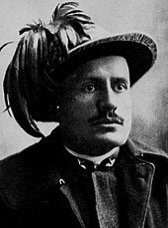 Mussolini,the bersaglieri
Mussolini,the bersaglieri
Hemingway was there in June and July 1918. Lemmi Adrian was gone by then. Papa Hemingway got his book A Farewell to Arms out of it, plus a bunch of shrapnel in his legs, and notoriety when he was wounded in July 1918.
He and American author John dos Passos signed up as ambulance drivers as did several other recognizable names including Walt Disney and writers W. Somerset Maugham and E.E. Cummings.
The Great War, as the Europeans called it, was the number one romantic adventure of the time for many young men, until it wasn’t.
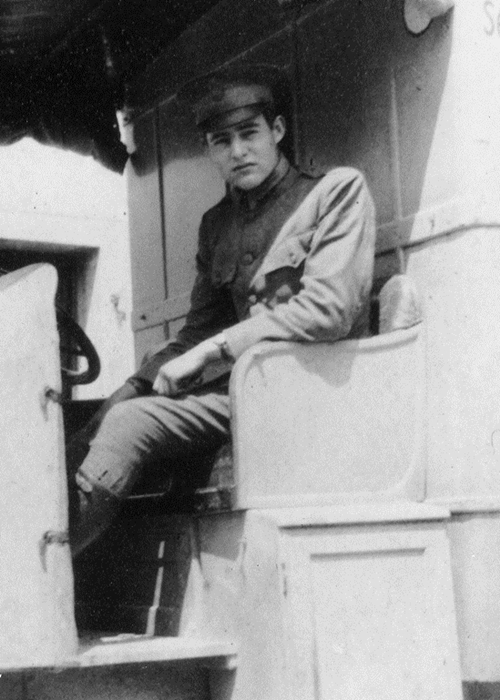 Hemingway in a Fiat ambulance
Hemingway in a Fiat ambulance
Hemingway just had to get there but couldn’t get in on the fighting because of bad eye, so he joined up as a driver with a private company running the ambulance fleet at the front. Dos Passos was more of pacificist, but as a writer he too just had to be there, not necessarily to do any killing, so he hooked up with the same ambulance group. Their Fiat ambulances developed a bad reputation for breaking down, and eventually were replaced with Model T Ford ambulances when the Red Cross took over the ambulance business.
The famous desert fox of WW11, Erwin Rommel, was on the scene at the Italian front and got the Pour le Merite for his brilliant quarter-backing in this little game.
Adolf was on the Western front as a young, very serious, no-nonsense soldier.
...oh oh oh it’s a lovely war
who wouldn’t be a soldier, eh?
Oh it’s a shame to take the pay...
Another photo from this era in my collection is this photo below of young soldiers and their knives. It was a novelty to me until I discovered that the knife thing was a universal pose in historic photos of the Italian outfit known as Arditi - the daring ones. (Ardire means ‘to dare’) The guitar player with cigarette is Milano Trapassi who survived the war and married my grandmother’s sister Santina. The Arditi were like the German stormtroopers and received special hand-to-hand combat training.
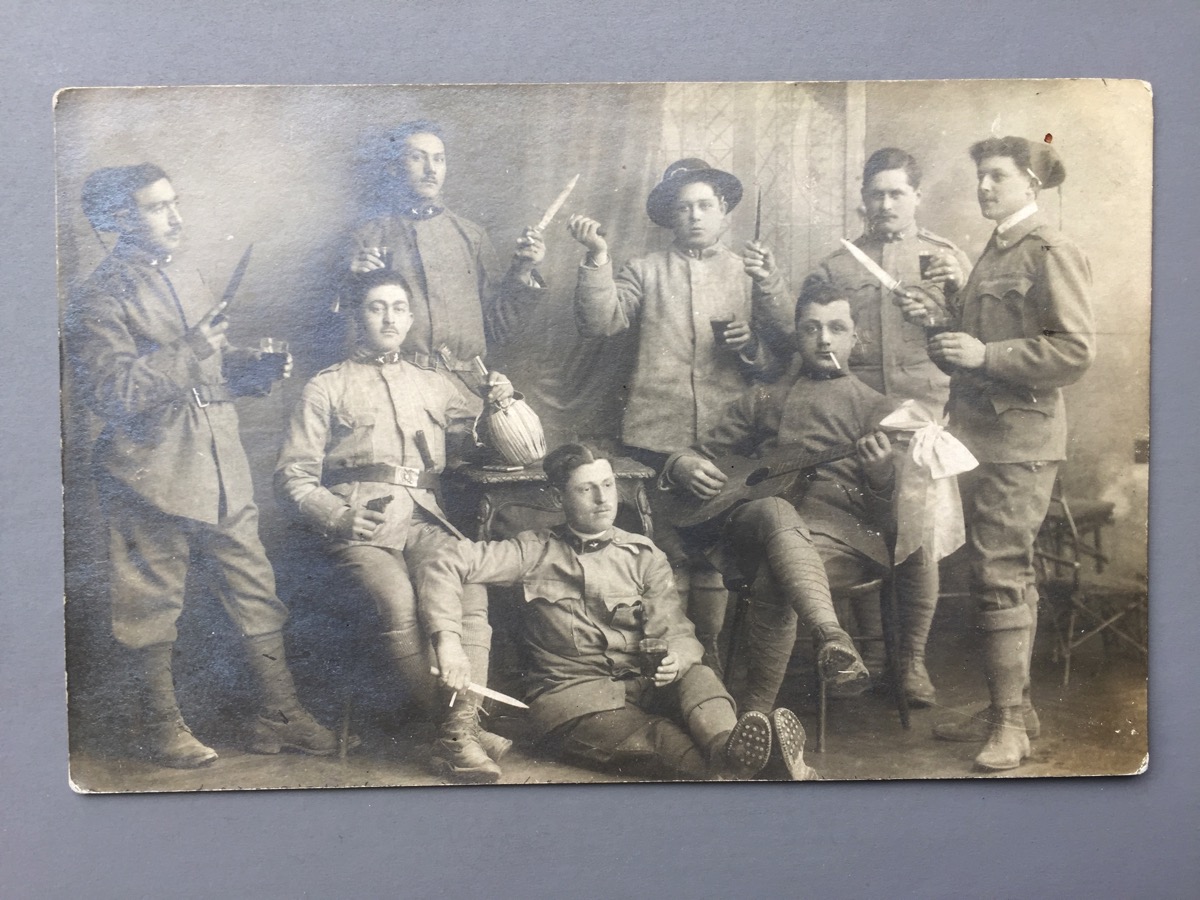
Milano Trapassi with guitar
Until I get more info on Lemmi Adrian’s precise unit and its movements, the best I can picture is he was probably captured in 1916 in one of the late battles of the Isonzo campaign. Italian soldiers were an unhappy lot. There was a lot of hiding from the draft both in the South and the North. The country was still a collection of diverse regions with their own dialects. To add to the confusion each regiment called up recruits from two different regions, then sent them to a third for training.
The Austro-Hungarians had similar diversity issues, but they had fortified the high ground in the mountains before and during the early stages of the war and were ready. The Italians were sort of ready, but they had more bodies than hardware outnumbering the opposition by about three-to-one. Life was cheap.
There were twelve battles over two years along a 400 mile front following the Isonzo river north of Venice. The Italians got about 10 miles into Slovenia and then it was a stalemate with high casualties on both sides, especially for the Italians climbing, dragging enormous guns with mules and muscle up the rocky landscape and facing the 8mm Schwarzlose M7 machine guns pointed down at them. There was trench warfare here like that on the western front, but here the ground was rock not mud and digging trenches was problematic.
The final battle of that campaign was at Caporetto in the fall of 1917 when the Germans finally appeared on the scene to back up the Austro-Hungarian effort and turned the tide on the Italians.
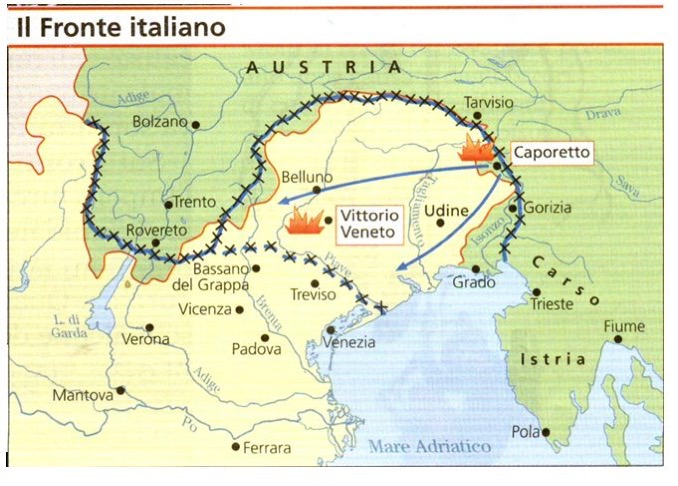 arrows show the advance of the Austrio-German forces after the battle of Caporetto
arrows show the advance of the Austrio-German forces after the battle of Caporetto
In each battle, especially at Caporetto, large numbers were captured by both sides and that’s how prisoner of war Lemmi Adrian ended up buried somewhere across the Italian border, probably near the hospital where he died, in what eventually became known as Yugoslavia.
The Italian records of WW1 are extensive and I suspect we can probably get another clue as to exactly where he is buried it we could find where he was taken prisoner, or the name of the hospital where he died, though it may be an unmarked grave.
Research on POWs in WW1 has increased in recent years.
Italian prisoners of war numbered about 600,000 over the years of the war. When it was over Italian political and military powers swept the fate of the captured under the rug wanting to move on quickly from that period. Damnatio memoriae.
I wonder if Adamo or any of the family in Italy ever knew the whereabouts of Lemmi’s gravesite.
……………………………………..
Adamo’s letter continues:
ha saputo che ai comprato l’automobile…..
i know that you bought a car
We don’t know exactly how Adamo discovered Cino’s new purchase, but many of the people Cino knew in Exeter were from Cireglio. A new car in 1931 was big news and was probably mentioned in many letters home.
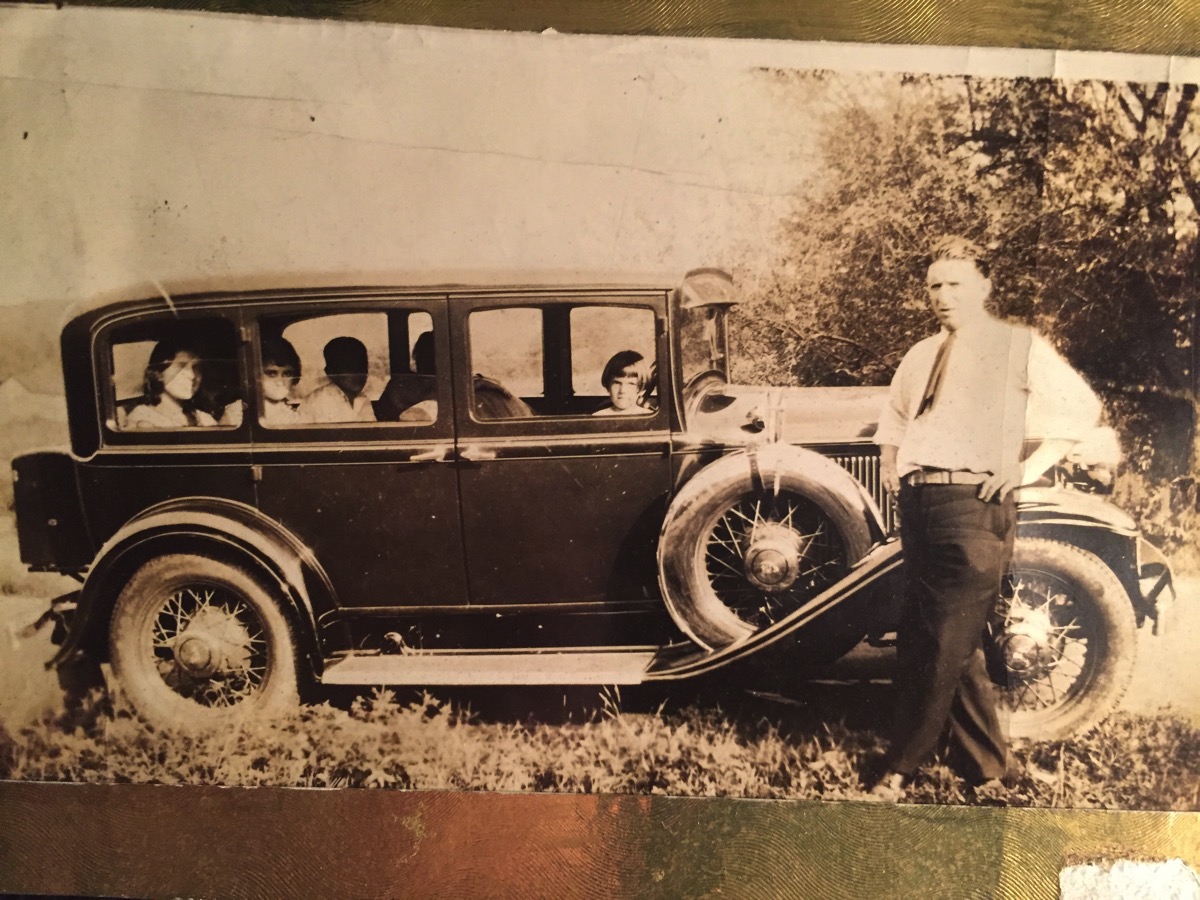 1931 De Soto in 1931
1931 De Soto in 1931
In the photo is Lydia (Giulio’s daughter) near the rear window, the others in the back are identified as Adrian and Liberty (daughter of Emma Paci Calvani). plus one mystery person in shadow. Fedora, as the favorite of my grandfather, had the honor of the front seat.
So Cino buys a brand new De Soto probably for about $850 at the height of the depression. There is a lot we don’t know about these guys. I know at this time they had the cabin at Spring Brook so that may have been a factor in getting a car, that and the general necessity of keeping up with the times. And, he had other income from his band which was going strong at the time, probably playing a couple times a month. The band was in Exeter’s Memorial Day Parade that year.
One of the features of the depression was a distrust of banks which led to people hoarding cash. Maybe Cino was turning his cash into hard goods.
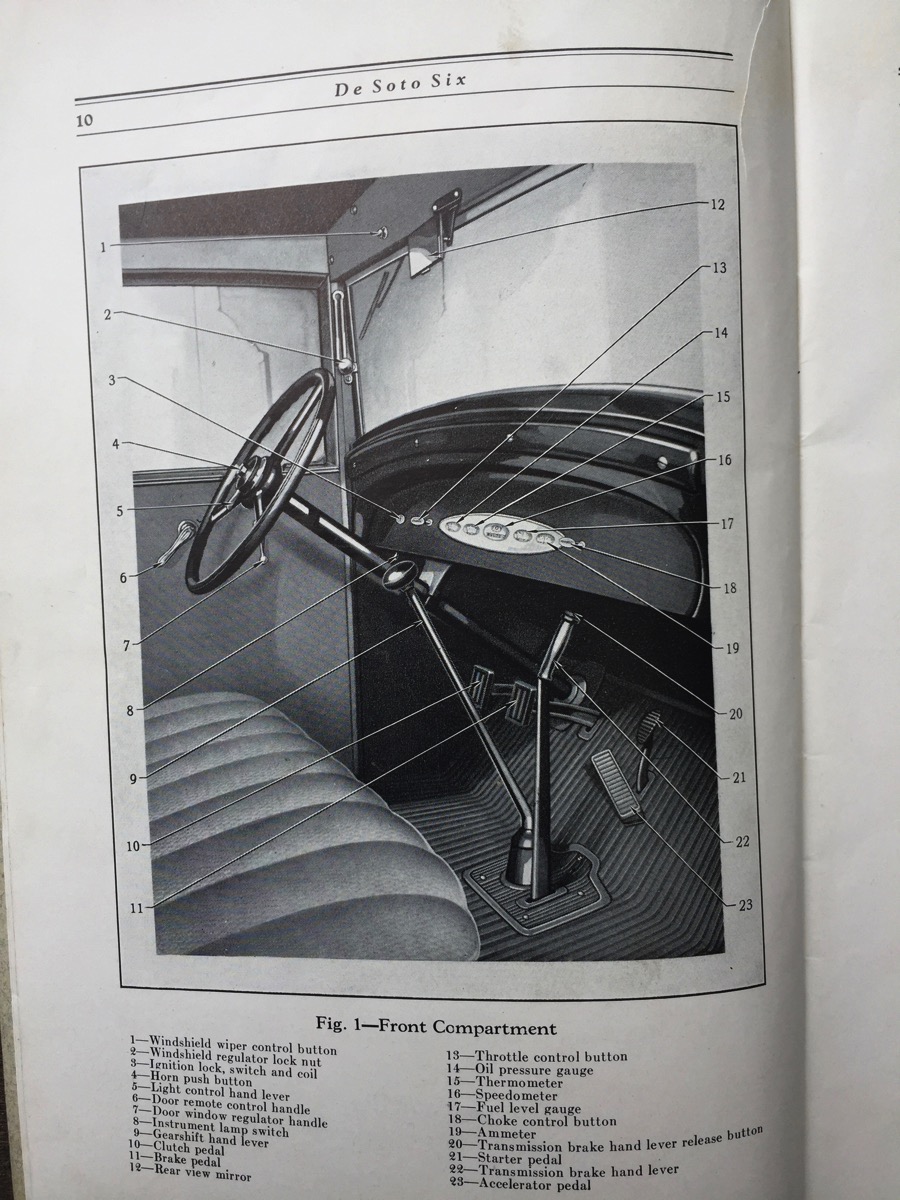
1931 De Soto Six: 67 horsepower, three on the floor, wire wheels, a pedal above the gas pedal was the starter.
The manual emphatically reminds the new owner to always lock the car. This is the depression, remember.
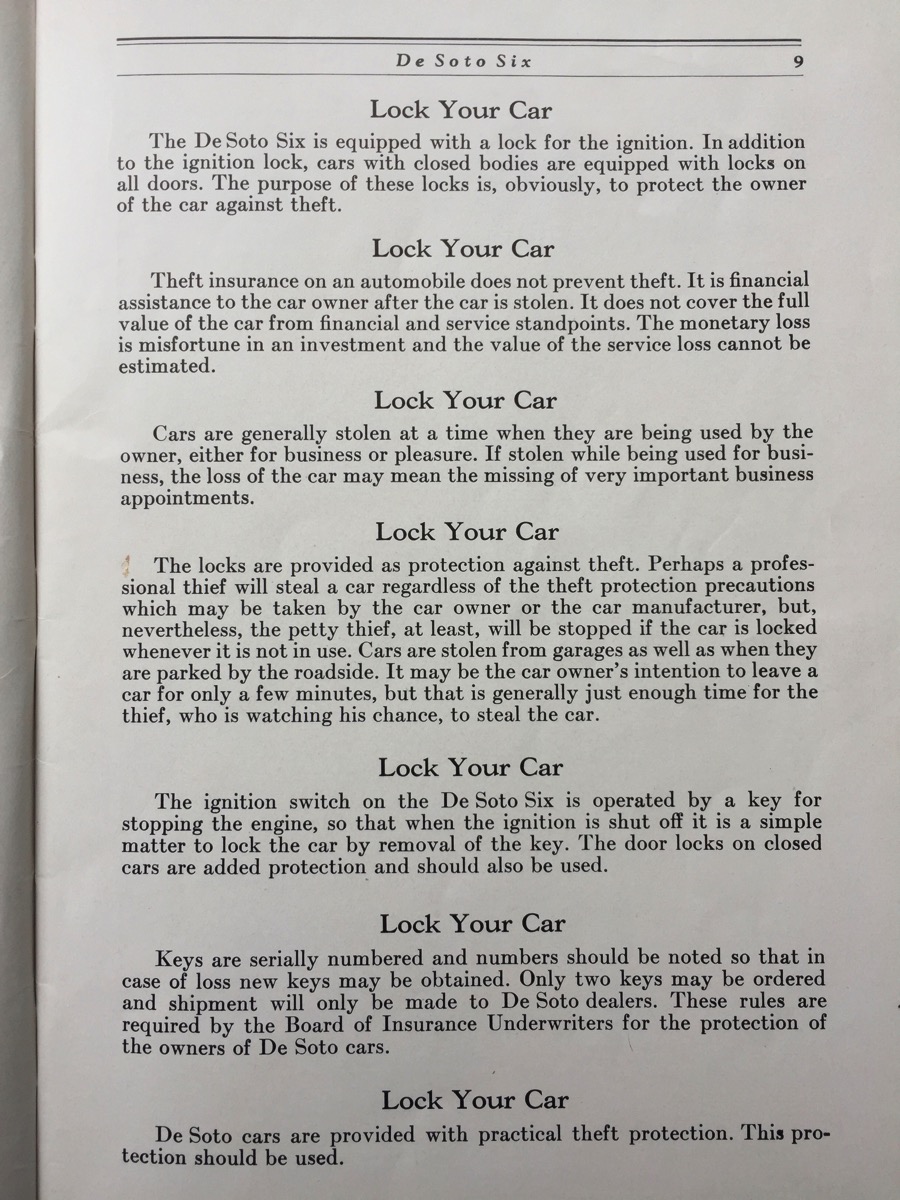
The postcard continues:
…….ho piacere
i’m glad
che vi…godiate tutti
that everyone’s enjoying themselves
pur che non pensiate
without giving a thought
al padre che vi oh
to the father who had
portato all’ epoca di guadagnare
carried (them) all these years
un figlio solo, eve e
only one son (Pacino?), Eva and
Corinna, gli altri nulla al
Corinna (have given him any attention), from the others nothing to the
povero vecchio
poor old man
godetivi e divertetiri e
enjoy and have fun and
salute vostro sfortunato
regards your unfortunate
padre Adamo
father Adamo
Unless he’s pulling Cino’s leg with a little old-fashioned guilt tripping, the ’sfortunato’ one must have thought by having 12 children he was insuring his future with dedicated subjects. He didn’t plan on wars or the siren call of America where the ‘money grew on trees’ according to his son Giulio.
Adding the ’s’ prefix to an Italian word like ‘fortunato’ reverses it meaning often to the negative.
………………………………………...
So that’s it. I stuffed this postcard into an unrelated envelope for safekeeping when i brought it home from Fedora’s collection a couple years ago and forgot about it until it turned up in the December housecleaning. I’ve been mulling over the 1931 world of Adamo and the Paci’s since the card turned up, and that led to the Lemmi Adrian business and WW1.
William Shirer in The Rise and Fall of The Third Reich says Mussolini made the mistake of seeking to make a martial, imperial great power of a country which lacked the industrial resources….and, unlike the Germans, the Italians were too civilized, too sophisticated, too down to earth to be attracted by such false ambitions’… “the Italian people, at heart, had never, like the Germans, embraced fascism. They merely suffered it, knowing that it was a passing phase, and Mussolini toward the end seems to have realized this…..”
And in the Caporetto book author MacDonald reiterates that: “Most (of the Italian soldiers) had little understanding of the reasons for the war and saw it as another ‘signore’ adventure.”
…………………………………..
 photo by RM Auctions
photo by RM Auctions
Since the core subject of the postcard is l’automobile here is the 1939 Alfa Romeo 6C Mussolini bought for his mistress Claretta Petacci. They enjoyed it for a few years until they were picked up near the Swiss border trying to escape to Germany near the end of the war in 1945 and were shot by Italian partisans. Their bodies were brought back to Milan where the two of them, and some others, were famously hung upside down in the square.
The car was confiscated, but later somehow was grabbed by a clear-minded American soldier and shipped to the U.S., used by his family until it broke down, and then stashed in a barn in New Jersey. Now, having changed hands a couple times and fully restored, it’s valued at $2.4 million.
And De Soto’s like Cino’s have sold for $8000 to $12,000 at recent auctions.
and i leave you with that….
-rp
Farewell to Arms, Ernest Hemingway (1929).
The Ambulance Drivers: Hemingway, Dos Passos, and a Friendship Made and Lost in War, James McGrath Morris (2017)
Caporetto and the Isonzo Campaign: The Italian Front 1915-1918, John MacDonald and Zeljko Chimeric (2011)
Rise and Fall of the Third Reich, William Shirer, (1960).
Posted by ronpaci at 1:11 PM
September 14, 2011
What’s a Biarritz?
Dear Boys,
It's come to my attention that my name was mentioned during your recent visit to the Radnor Hunt Concours of fine automobiles.
As you all gazed upon a Cadillac Eldorado Biarritz the question came up "what's a biarritz?" and in my absence you were left to wander the wilderness of the main line in ignorance.
Let me help you with that question.
Biarritz is a town of a little over 27,000 conflicted souls in the south of France who don't know whether to call themselves French, Basque, or Spanish since it's 11 miles from the French border with Spain on the Atlantic coast, and Basques are unwilling Frenchmen.
Don't try to dig out the origin of the word from the French or Basque language.
It's Scandinavian. The Vikings discovered the place in the early 800's AD and went nuts over the topless babes on the beach. They named the place Bjarnihus, which means the house of Bjarni. Bjarni had the biggest broadax onboard, and to avoid having their blond noggens lopped off the guys let him put his name on the place.
Time went on, and the Basque and French babes wore the Vikings down and contaminated that pure northern blood. Soon the Bjarnihusen did what they pleased, and they decided Bjarnihus was a ridiculous word so they named the place Biarnitz.
After a few hundred years more of diluting the Viking thing the Biarnitzen decided Biarnitz was too hard to say after three or four bottles of Bordeaux and went with Biarritz, which is the sound you make after drinking three bottles of Bordeaux.
The weather there is great, and in 1854 the wife of Napoleon III (who called himself that due to a lack of imagination) built a monster palace there to escape Paris in the summer, which sucks.
.
The next thing you know the Brits - queen Victoria and prince Albert in a can - start showing up. They put the kibash on the topless routine, and everybody hated them for it.
Around the turn of the century the Americans discovered the place, including Charles Stewart Mott and William Durant, the co-founders of General Motors.
They too were knocked out by the displays on the beach, and when they were old men they tipped their hats to those memories in the design of the early '50s Cadillacs the bumpers of which were called Dagmars.
In 1926 Hemmingway mentions Biarritz in The Sun Also Rises, and after the war, Gary Cooper and Sinatra are hangin' and the name of the place becomes synonymous with "class" like a gold chain necklace.
Goombahs and Cadillacs go together like Martin and Lewis, so in 1956 the Detroit geniuses decided to give the convertible model of world's most audacious automobile - they wore out one steel mill for every 100 Biarritz's that lumbered off the assembly line - a classy name.
And to match your gold chain, the emblems were now gold....uh...gold color....
As the years rolled on your 7 grand bought 5000 lbs of class with twin four-barrels burning a gallon of 23-cent 97-octane Golden Esso Extra every 10 miles, unless you were piloting your 18-foot long Detroit iron 100 mph down a dark desert highway with the cool wind in your hair, in which case it would be less.
It was a great car to drive according to my octogenarian friend John Neary who navigated his dual-quad '57 coast to coast, and still dreams of his foot on the floor searching for an Esso sign.
He writes: "Forgot to mention making the memorable back and forth trip in my beloved '57 Eldorado Biarritz convertible mit der two four-barrels.... Would you believe I wound up turning that gorgeous old beauty-- push button everything, leathern seats, tonneau, sheepskin carpets, the works-- over in 1971 to two neighborhood kids for $125? They painted it sea green, with a broom...."
And that's why the Cadillac Eldorado convertible is biarritzy.
Are there any more questions?
rp
Posted by ronpaci at 11:11 AM
July 1, 2011
No Beeping Zone
WINE COUNTRY, Northern California. - Thursday June 16 - I wish I could transport my cave wherever it is I go.
Best I can do today is huddle here in a quiet area behind our pleasant nor cal hotel. I'm trying to read the hundred years worth of books I've downloaded onto my Ipad before I turn 70, a year and a half from now; and I'm avoiding my wife's family who are spinning in a noisy female cyclone of activity preparing for the marriage of a niece. But every 90 seconds or so an electronic "beep" from somewhere nearby pierces my harmony and disrupts my train of thought.
I heard it earlier this morning from my bed near a window. I looked around briefly but couldn't locate it. First it beeped loud and seemed to come from one direction, then it beeped soft and seemed located somewhere else in the lawn.
This afternoon the line was crossed. All I wanted was some peace and quiet and to continue reading Moby Dick, Melville's dark novel about the limitations of the Christian view of what it means to be a human being.
My mood is especially cantankerous, more fed up with humanity (10 on a scale of 10) than normal (9 on a scale of 10) after the mind- numbing cross-country trip yesterday in a plane filled with chatty kathy's.
Again with the beep. In the modern world electronic beeps are constantly demanding attention, directing our actions; and one by one deleting another bit of our innate ability to decipher the universe with our own senses and intelligence. Rarely can we turn them off or control the volume. But some we can, like my 1987 car which has been silenced; and I'm working on the toaster oven.
So i stood like a man who forget what he was about to do in the middle of the nice area with big oaks and a hexagonal gazebo bathed in the annoying California sunlight, and at every beep I moved a little closer to the perceived location.
Baffling.
Another beep, another guess.
Finally i kicked something on the ground while taking one of the steps. There's no one around, besides this is California, everyone's oblivious anyway.
In the grass a small solar panel set in a round, plastic, saucer-sized disk beeped at my foot. Found it.
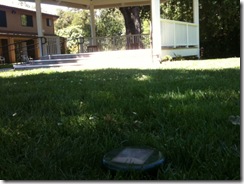
I tried to pick it up but it was stuck firmly into the ground. I spun it, lefty loosey, thinking it was screwed down like a landscape device. After a couple turns it came out: a green disk with a 3"x 3" solar panel attached to a 14-inch long smooth metal tube with a pointed end.
BEEP.
"Go ahead beep again, what ever you are, because in ten minutes you are going to be silenced."
Unarmed with my usual array of switchblades and screwdrivers, I threw the irritating piece of mysterious technology into the car and went to the hardware store a few blocks away for a #1 Phillips screwdriver.
It beeped the whole way.
The kid at the counter said it was probably a gopher stake meant to drive away gophers. I like gophers. so now my mission gained new meaning.
I was prepared to clip wires. I was prepared to throw it into a ditch.
In the car outside the hardware store, armed at last, I ripped the plastic packaging off my new $7 screwdriver like a surgeon about to crack open the chest of a gasping heart patient and unscrewed a single #6 x 3/8" round-head sheet-metal screw at the top of the stake which then fell free of the solar panel disk. Three wires led from the disk into the stake attached by a small electronic plug until I detached it.
Silence.
Success.
Smile.
Back at the hotel I reassembled the thing, wires now disconnected, and returned it to its place in the lawn.
Back on the high seas Ishmael and the crew of the Pequod had just killed the first whale of the trip and were in the process of peeling off the blubber like Melville is doing on another level peeling layers searching for an answer to just what is that inscrutable thing: "be the white whale agent, or be the white whale principal...."
"Now as the blubber envelopes the whale precisely as the rind does an orange, so is it stripped off from the body precisely as an orange is sometimes stripped by spiralizing it."
Melville has some good ones:
"Oh, (give me) time, strength, cash, patience."
"Better to sleep with a sober pagan than a drunken Christian."
"Talk not to me of blasphemy, man; I'd strike the sun if it insulted me."
.......................
Damn, the women are back......
................................................
e pur si muove
Sunday June 19- Ironically, it turned out my selfish act of eco terrorism had an unintended beneficial consequence. The wedding vows were made yesterday on a balmy afternoon in the gazebo a few yards from the gopher stake, now silent and benign.
Ishmael, the Christian who appreciates his pagan friend Queequeg and his ways in the novel, would have found this totally secular wedding interesting. Not one speck of religion in the whole affair.
And yet they are married.


Posted by ronpaci at 11:42 AM
February 15, 2010
ZEN AND THE ART OF SNOW SHOVELING
empty head, (easy for me)
scoop,
lift,
transport,
pitch,
repeat.
..............................
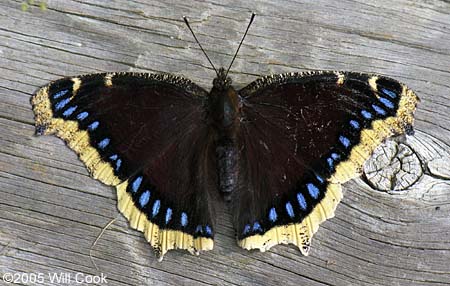
FREEZE CAN'T TOUCH ME
Amidst a load of firewood that came into my possession hours before the first big snowfall last week, I inadvertently unearthed a hibernating Mourning Cloak butterfly.
I discovered it living in my van two days after I unloaded the well-aged wood. As I was driving, I heard a fluttering struggle against the glass of the van's rear window. Looking at it in the rear view mirror I thought it was a moth, being ignorant of what butterflies, other than the migrating Monarch, do in winter.
Back home, butterfly/moth book in hand, I watched it sun itself still inside the van, now parked in the newly-shoveled sunny driveway. The wonder was perched on the chrome latch of the rear window, wings full open, showing dull reddish-brown surfaces with a faded yellow border, and small blue spots near the yellow. Fuzzy body. Four legs.
Best guess after leafing through the book was Mourning Cloak. But in winter?
Turns out the Mourning Cloak is known as the 'winter butterfly'. It is able to 'freeze', hibernate, and come back when tree sap, their primary food, starts flowing during the first warm days of Spring, usually in March; then they mate up, and die. Life span: ten months.
I read a news story a couple weeks ago about insects that produce an anti-freeze protein that allows them to endure sub-freezing temps without cell damage. That feature has implications in human organ preservation which was the point of the study discussed in the article.
Right or wrong, I'm keeping my Mourning Cloak, as yet un-named, as a pet for the duration.
... banana, peaches, water, on the look out for tree sap....
The top of its wings has the same pattern, though a little faded, as the open-wing image in the little photo below this one.
Somebody better refinish that window sill. The two brown spots on the wood are either from box elder bugs which hang out with us pretty much year round; or from a stink bug, an invasive species, but prehistoric-looking and interesting .
Haven't trained mine to open his wings on demand, yet.....
Posted by ronpaci at 9:38 PM
June 14, 2009
JUNE VISITORS
June is the month for dragonflies in the mid-Atlantic area. Every year a Swamp Darner strays into my workshop to be photographed:
I think it liked the green of my glove.
------------------------------------------------------------------
Posted by ronpaci at 5:32 PM
April 9, 2009
Cherry Blossom Gems
By Ron Paci
Craftsman at Large
Early bud, March 8

Extended florets, March 21
Just past peak, April 5
These are some of the original trees. They have a placid existence 346 days of the year.
The crowds don't come for the buds.
The blossoms draw the crowd.
And everything that comes with them.
-------------------------------------------------------------------
Magpie knowledge - that's what a Brit friend of mine said his college professor accused him of displaying; when he told me that I rejoiced in finding another kindred spirit. The implication being that his knowledge of the subject at hand is incomplete, and gained in an unstructured way, i.e. not from formal studying.
-------------------------------------------------------------------
Some interesting Magpie gems discovered during the cherry blossom project:
Two manmade objects placed among the Tidal Basin cherry trees, a Japanese stone lantern and a stone pagoda are probably the oldest objects outdoors in Washington. The lantern was 300 years old when it was presented to the city in 1958, sculpted in 1651 according to the press releases. The Stone Pagoda, a gift to the city by a private citizen, may date to the 12th century.
------------------------------------------------------------------
Washington, the city, and seat of the government, came into official being in 1800 when the capital was moved here from Philadelphia. There were a little over 10,000 whites, and a little over 3000 slaves here at the time. 'Washington,' the place, belonged to the Piscataway Indians before that. They went west.
Tokyo, the city, and the source of our cherry trees came into being in 1457. Before that, 'Tokyo,' the place, was populated with the ancestors of the new city of Tokyo. They brought along some traditions.
In Washington, cherry blossom interest dates to 1912. In Japan, well, back a ways...
 The stone lantern is a Buddhist object. Both lantern and Buddha appear in Japan in the 6th century. The first lanterns in Japan were made by Chinese craftsman.
The stone lantern is a Buddhist object. Both lantern and Buddha appear in Japan in the 6th century. The first lanterns in Japan were made by Chinese craftsman.
The ceremonial lantern lighting in Japan is a metaphor for banishing the darkness of ignorance and illusion; here in the nation's capitol we use it to celebrate the crowning of Miss Cherry Blossom Festival; she gets crowned with a $300,000 crown with 1,585 pearls set in a gold frame ringed with a band of ermine fur. She only wears it for a few ceremonial minutes because it's so damn heavy; then it's back to the vault.
The golden age of stone lantern making in Japan was in the 12th century; so, by their standard, the one they gave us, to commemorate post WWII friendly relations and to mark the 100th anniversary of our first trade agreement with Japan, was a relatively new model. Not that there's anything wrong with that.
The Eastern religions rely on symbols to bridge the weak human mind to the ultimate truth which is unknowable, indefinable, inexpressible in the language of men. Well, that gives one a lot of wiggle room. These stone sculptures are loaded with symbolism
There are 9 major categories of lantern styles and 75 subcategories. They started being used for non-religious ceremonies - tea rituals - in the 16th century and like anything Asian, it is a slippery slope into arcane, obscure and confusing, so a few magpie sparkles will suffice to get one's head above the crowd.
Our lantern's 8-feet high and weighs a couple tons. Everything on it means something. The hexagonal construction defines its type; there are seven named divisions bottom to top. The third section from the bottom is an inverted lotus leaf; top of the shaft another lotus leaf. Lotus is the flower of paradise, a symbol of purity.
The fire box has a crescent moon, a circle representing the sun, a square opening representing earth, and the three circles represents the triad of Buddhism.
The inscription on the shaft has been translated as:
This stone lantern is dedicated to Daiyuinden at the Toeizan Temple of Musashi Province this twentieth day of November of the fourth year of Keian by Matsuura-Shizunobu, Lord of Hizen.
What does that all mean?
'dedicated to Daiyuiden...' Daiyuinden: is the posthumous name of Tokugawa Iemitsu, the third shogun of his family's reign. The Japanese honor royalty with a posthumous name, in this case the name of his reign. Iemitsu was the grandson of the first Tokugawa shogun, Leyasu, who started the dynasty in 1603; his base of operations was Edo, Edo Castle, which became Tokyo, which is where our cherry blossoms came from.
Japan was a military dictatorship for 7 centuries, 1185 till 1867. The dictators were called shoguns, and their power was maintained by their samurai. Class lines were rigid: emperor, nobles, samurai, farmers, craftsman, merchants (parasites), entertainers, beggars, executioners. Rules were followed, and not incidentally, sword making became an art at this time. It was a period of isolation both in Japan and China.
In 1600, William Adams, a Brit seaman, sailing on a Dutch ship (the English and Dutch were allies against the Catholics, but we won't go down that road) was washed ashore and became the first Englishman in Japan and the basis for the James Clavell novel of feudal Japan: Shogun.
Later, in 1853, Commodore Mathew Perry and his steam powered black ships pulled into Tokyo Bay in July seeking trade with the Japanese and a safe harbor for our long reaching whaling ships. They 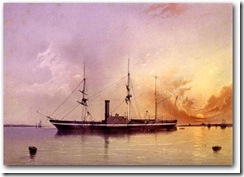 wouldn't let him in. And he refused to speak to low level dignitaries. Finally, after much discussion, the trade agreement paperwork was signed in March 1854; and we dealt with the Shoguns for another 13 years. The presentation of this lantern commemorated the 1854 agreement.
wouldn't let him in. And he refused to speak to low level dignitaries. Finally, after much discussion, the trade agreement paperwork was signed in March 1854; and we dealt with the Shoguns for another 13 years. The presentation of this lantern commemorated the 1854 agreement.
The Toeizan Temple, mentioned in the translation as the place where the lantern was dedicated, was built in 1651, the same year our lantern was sculpted, and is the burial place of the Tokugawa shoguns. The temple is in Ueno Park, Tokyo's first public park, and the site of the last battle of Tokugawa to hold onto power. He lost that battle, and in 1867, the Emperors are back in business.
The Musashi Province, where the Toeizan Temple is located, is the period name of area of Tokyo.
Year of Keian is the name of an era, 1648-1652.
Matsuura Shizunobu, who dedicated the lantern in 1651, was Lord of Hizen: Hizen is the period name of the southern most island of Japan. Nagasaki is here. The modern name of the Hizen area is Kyushu. Matsuura Shizunobu was the local warlord, daimyo, of the Hizen province and ruled from the famous Hirado Castle. This was the port of entry for the Jesuits in 1550, and the Dutch traders in 1600. The Hirado clan monopolized the Dutch trade, which caused no end of conflict; and Hizen is where William Adams died.
------------------------------------------------------------------
 The park service marker describing the stone pagoda says it was given to a former D. C. Commissioner, Renah Camalier, by the mayor of Yokohama, Ryozo Hiranuma. Camalier later gave it to the city to place among the Tidal Basin cherry trees. And then, the Japanese rededicated it to the city of Washington. What's that all about?
The park service marker describing the stone pagoda says it was given to a former D. C. Commissioner, Renah Camalier, by the mayor of Yokohama, Ryozo Hiranuma. Camalier later gave it to the city to place among the Tidal Basin cherry trees. And then, the Japanese rededicated it to the city of Washington. What's that all about?
Until 1967, the District of Columbia was governed by three commissioners appointed by the president, two civilian commissioners, and a commissioner from the military corps of engineers. Camalier was named D.C. commissioner in 1952 by Truman, and he stayed on after Eisenhower took office in January 1953. It  was in '53 that Hiranuma visited Washington and gave a personal present to the 'mayor' of Washington. I haven't unearthed the circumstances of that occasion or the nature of their relationship, but when the present finally arrived in 4 or 5 crates at the Port of Baltimore four years later in May 1957, Camalier wasn't sure what it was. No longer commissioner, he passed the present, what ever it was, off to the city.
was in '53 that Hiranuma visited Washington and gave a personal present to the 'mayor' of Washington. I haven't unearthed the circumstances of that occasion or the nature of their relationship, but when the present finally arrived in 4 or 5 crates at the Port of Baltimore four years later in May 1957, Camalier wasn't sure what it was. No longer commissioner, he passed the present, what ever it was, off to the city.
And, as related on the marker at the pagoda, they turned it over to the Smithsonian guys to put it together.
The stone of the pagoda is not as fine as that of the lantern. The softer material has weathered, and the carvings
have lost definition. But some who studied it earlier say the buddhas carved on the sides of the base, and design are consistent with an earlier period than stated on the marker. A brass commemorative plaque has gone missing.
Posted by ronpaci at 11:23 PM
March 16, 2009
Marching Toward the Equinox
From Ron Paci
Craftsman at Large
Say hello to L129, and one of its second stage buds.
.......and L133.
And the rest of the venerable Yoshinos who have been on duty for 90 plus years here at the northwest corner of the Tidal Basin, formerly a swamp, here in the nation's capitol. The trees are numbered. That's L139 in the foreground with the big Y.
Each year the blossoms of the 3,700 or so trees around the Tidal Basin create one of the city's biggest traffic jams. They are in the background of family photographs in homes around the world.
For two years, when I worked near Capitol Hill, I rode my bicycle around the Jefferson Memorial side of the Tidal Basin and watched the blossoms from bud to bloom. Some years I missed them completely. This year I'm going to watch them close-up.
----------------------------------------------------------
Usually on a bleak daylight deprived January day, Louis Halle comes down from his place in my bookcase, and wanders around the house. Sometimes he's in the kitchen. Sometimes on the shelf by my bed. Some evenings, in the living room. He moves around a lot as we compare notes on our Spring watches.
In 1945, Louis decided he was going to be the official observer of Spring in Washington and he wrote a book by that name. From January to June he rode his bicycle from his apartment in Woodley 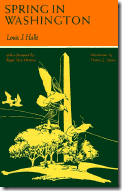 Park near Connecticut Avenue to work at the State Department. He took the long way. Sometimes a 5 or 6 mile long way; then back again to his office on Constitution Avenue.
Park near Connecticut Avenue to work at the State Department. He took the long way. Sometimes a 5 or 6 mile long way; then back again to his office on Constitution Avenue.
His year, forever captured, is well known in the birding community. The birds he saw that Spring were the focal point of his observations. Roger Tory Peterson was here that year too, and wrote the forward in my copy of the book. Most years some journalist will make a note of it in the local papers. The older book stores know right where he's kept.
"Every morning now is fresh wonder, no two quite the same. Thursday, March 1, a cloudless day, the west wind blowing easily across the city. By the time the sun rises now, about a quarter to eight, I am likely to be across the bridge and into Virginia, having myself arisen in the starlight....All the birds are sparkling and ebullient in the sharp dawn. A redwing at the top of a tree is singing...Three grackles are clucking and grating to one another in the thicket. This is life beginning....emerging from the darkness and damp into the new day. It is spring in microcosm."
Louis skips over March 2, the day my father was killed in Germany.
He picks up again on Saturday, the 3rd. On a ride around the Tidal Basin, he notes: for the first time, the Robins are vocal.
I learned from him that the first note spring is actually heard in January, when, after weeks of cold, and avian silence, one morning the singing begins. I heard it this year. The Sparrows woke me; a few days later the first Cardinal call.
Louis had a big mind. A sensitive mind. I think the years of war drove him to his self-appointed task; he just couldn't take it any more; he turned to nature: "To snatch the passing moment and examine it for signs of eternity is the noblest of occupations......Therefore I undertook to be monitor of the Washington seasons, when the government was not looking."
As the season unfolds he sees an amazing variety of birds, including a couple bobwhites on Constitution Avenue. One Saturday, he rides 20 miles to Mount Vernon. He follows arrival of the warblers, and ends the first week in June after a little over 200 pages with his last sighting of a warbler for the season, a Blackpoll, behind the Japanese embassy. On nearly every page are words to live by.
He never describes his bicycle; though, in one of the many drawings in the book there is a bicycle with drop handlebars and a derailleur gear change mechanism. Very advanced, and probably rare in the U. S., in 1945.
Over the course of his life he wrote about 22 books on various subjects spiraling upward into an ivory tower, surely away from the crowd, judging by the density of his 1977 book Out of Chaos. It is a 646 page tome of everything he knew, and could find out, about everything. He called it "an exercise in perspective." He said all his life he tried to keep an eye on all basic knowledge, and in this book he lines it all up from quantum physics, through cell biology, evolution, ancient history, and more, onto music. He wrote it when he was in his mid-60's, after his retirement as a professor at the Graduate Institute of International Studies in Geneva, where he went after he left the State Department in 1967.
He died in 1998 at 87. He had Alzheimer's.
---------------------------------------------------------------
The Yoshino cherry trees of the Tidal Basin had a hell of a time getting started. It was 'Big Bill' Taft's wife Nellie, who finally made it happen. She learned about things Asian when Taft was governor-general of the Philippine Islands, now ours, in 1900-03. Asia was happening in those years; American artists and architects were using Japanese and Chinese motifs.
After years of lobbying by several people, some spending their own money, to get official Washington to use the dramatic flowering cherry trees on streets and parks, it took Nellie's interest to finally get them here; in 1910, the first boat load of 2,000, a gift from the mayor of Tokyo, arrived.
Unfortunately, they had a frightening degree of infestation, and after a lot of fretting, President Taft finally caved in to the recommendation of USDA scientist/inspectors, and ordered them burned, despite the tears of his wife and others.
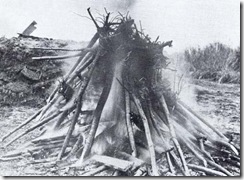 We'll just say 'they fell off the boat...' NPS photo
We'll just say 'they fell off the boat...' NPS photo
That incident, commonly reported in the cherry tree history, had some far reaching implications. Over 70 percent of the trees were contaminated with root gall worm; 45 percent showed evidence of crown gall; other unpleasant visitors included San Jose scale, Sesiid moth, weevil, canker worm, and, my favorite: black thrips.
Sesiid moth bores and feeds
San Jose scale: insect grows a
shell and feeds beneath. Can suck a tree dry.
 Mr. Black Thrips eats stems and leaves
Mr. Black Thrips eats stems and leaves
There were no quarantine regulations at the time. One of the USDA scientists involved in the inspection was Nathan Cobb, who came to be known as the father of nematology. His statement about the event led to the passing of the first Plant Quarantine Act in 1912.

NPS photo of the inspection
The whole thing was a diplomatic nightmare. Somebody suggested reporting to the mayor of Tokyo that they fell off the boat. After tiptoeing around the matter, another batch arrived in 1912; this time 3,000 in number, and thoroughly fumigated.
Their average life span is 40 years, but through propagation and grafting from the originals, the population has been maintained. Many of the originals from the first planting are still scattered around the edge of the water, kept alive beyond all expectations by constant care. Though, there have been losses from time to time.
A few days after Pearl Harbor, somebody cut down four of the trees; and for the remainder of the war they were referred to as 'Oriental flowering cherry trees.'
In 1999, beavers made an appearance, and started causing trouble.
Predicting exact day the famous ring of trees will blossom has eluded planners of the annual festival since the first big one in 1934. The trees have their own formula to decide the exact day: the length of the day plus the minutes of sunlight times the average rainfall from Feb. 20-March 20 divided by the number of minutes of over 60 degrees in temperature times the square root of the minutes of southerly wind over 30 days plus the speed divided by the number of minutes under 45 degrees of temperature, and the rest of the formula is pure speculation.
The blossoms rarely last more than a few days, a wabi sabi metaphor of the brevity of life itself: Now you see them, now you don't. Like Louis says: "For a few ticks I am here, uncomprehending, attempting to make some record or memorial of this eternal passage, like a traveler taking notes in a strange country....."
In the coming days I will attempt to record the march from buds to blossoms on cherry trees 129, 133 and their neighbors, the closest trees to my favorite stealthy, but illegal parking spot.
Posted by ronpaci at 5:15 PM
March 8, 2009
The Electronic Ax Man
a ramble from Ron Paci Craftsman at large
ARLINGTON, VA. Monday, March 2: I cursed the snow at 9 a.m. today; and then i took it back. In my back yard, the white cover made a perfect backdrop for a photograph to show the form of this clever chair.

There are a number of things about my shop and property that are old and unimproved. Among them, this rusted steel garden chair, a design from the ‘50s, the small steel wire table in front of it and, in my workshop, a wood lathe, circa 1952, purchased from a local used-tool dealer.
The Japanese have a philosophy about appreciating things in various states of decay; things with good form, yet unpolished. They call it wabi sabi.
The idea is a reverence for aging and imperfect objects, natural or man-made; and being one of those objects, it’s an attractive concept to me personally.
The aesthetic of wabi sabi is far more complex than a few descriptive phrases. But one of its essential values is an appreciation of things evolving from and devolving toward nothingness; a nothingness filled with potential.
------------------------------------------------------------------
A client runs a very organized business, The Brass Knob Warehouse, selling used building materials and fixtures out of a large building in the middle of Washington, D.C. He arranges with builders to strip houses and commercial buildings due for demolition; and over the years he has filled his warehouse with neat rows of radiators, bath tubs, sinks, hundreds of doors, doorknobs, cabinets, locks, keys, and windows of all descriptions.
Several years ago, by his invitation, I spent one of the last sunny spring afternoons witnessed by a modest brick house on a dramatic bluff overlooking the Potomac, a little over five miles up river from downtown Washington. A vantage point not otherwise available because this line of land is populated with multi-million dollar homes with gates across their driveways.
The back hoe and bulldozer were in the drive waiting for the next day. Mechanized devolution.
But, for this single afternoon I had the place to myself. My friend, Ron, had come and gone; he said I could have anything left behind.
The chair was upside down in the front yard, and the interior of the house was filled with debris abandoned by the former residents, people of means who had lived their lives, raised their children, and grown old here. After searching for any priceless first editions among the numerous books strewn about, I spent the remaining afternoon hours high above the river, piecing together the lives of the former residents from what they had left behind, watching osprey glide at eye level over the water, and becoming friends with my new chair.
This area of the river is the final reach of tidal water, and it boils in the early Spring with rainbow smelt seeking the fresh water coming downstream. They spawn at night; and are greeted in the morning by a small horde of fisherman snagging and netting, visions of frying pans in their heads.
The quiet of the afternoon was rudely broken a few times every hour by helicopters flying low over the river from from the Pentagon to the CIA building and back again. CIA headquarters is another 2 miles up the road from the doomed house.
The small lot the doomed house sat upon nurtured, at least for another day, trees gone wild; crooked, with rotted branches; tolerated for years, perhaps enjoyed, by the former owners. Flower beds near the house hadn’t felt a delicate hand with a trowel for several Springs. Though the daffodils were indifferent to the lack of attention, a grape arbor structure collapsed and was overgrown; wisteria was getting ready to power up the brick walls.
The new mansions on either side wanted nothing to do with wildness. Gas-powered leaf blowers, lawn mowers, and chain saws visited every Thursday.
Late in the afternoon, I loaded the van with about fifteen two-foot squares of slate that once formed a small patio, a few soiled books, my new chair, and went home; without looking back.
-------------------------------------------------------------------
In the 50’s, furniture using wire and wire mesh became commercially popular, most famously through designers like Charles and Ray Eames and Hans Knoll. Harry Bertoia, an Italian-American sculptor, worked for both of these design shops, and it is his name that springs to mind whenever wire chairs are mentioned.
The source of my chair is probably a local retail store and of no value. A neighbor has two on his front porch. But its design, influenced by Bertoia and others, fascinates me. Draw a circle. Now, build a chair around it. Brilliant. It is easily a two hour chair. Maybe three, if you have them.
I have made 10 chairs over the years, a set of eight, and two reproductions; and have repaired hundreds. There’s a lot of engineering involved to make a chair you can sit in for any length of time. The set of eight cherry chairs go with a trestle table. My two reproductions are on either side of the original walnut chair below.

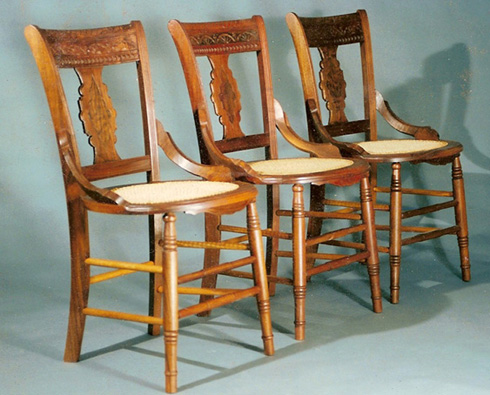
---------------------------------------------------------
My old wire chair has the unique quality of blending in, nearly invisible in a natural landscape, when not covered with snow, yet ready to do service for extended phone conversations, or for rare moments of doing nothing at all. A chair more nothing than something.
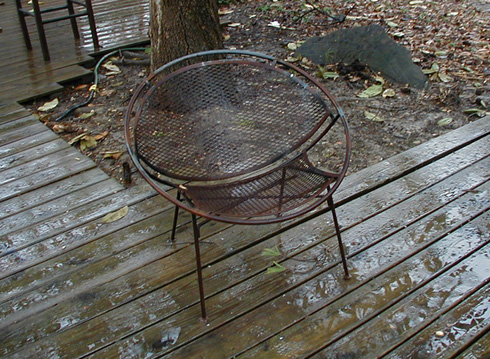
As the aesthetic of wabi sabi is greater than a simple description, the making of a chair requires making more than ten to really get it right. I make no claims.
-----------------------------------------------------------------
My wife, whom I refer to as Blondie when writing about her, picked up the little wire table shown above with the metal chair. Another gift of trash night. It is in phase three of repairs. The vertical wires forming the leg had broken away from the one-inch steel balls they were welded to. My first fix was to wire them together. When the weather breaks, there is usually a flurry of yardening and fixing around here; one year I stepped up from wire to a stainless steel hose clamp. Last year, I acquired a acetylene welding torch. I think the little table will go on for awhile with the third level of welded repairs. It is rusting nicely. The glass top, under the pancake of snow in the photo, is a perfect fit; a gift from an uncle “who art in heaven” as my octogenarian friend John refers to his beloved departed.
-------------------------------------------------------------------
The wood lathe was probably used in a local high school fifty years ago. The used-machine guy I bought it from has connections with local governments. It is stoutly and simply made, mid-level quality, and came with many accessories, including a small section of the base, a key part. By rigging up that attachment you can make the lathe any length.
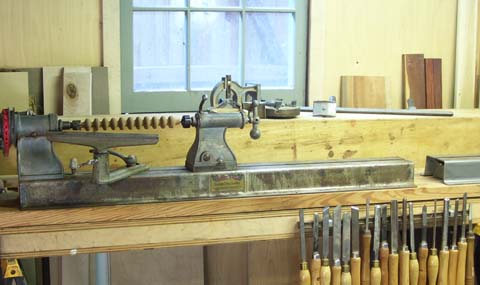
I used it to turn these roller clamps for the Freer Gallery. Japanese scroll paintings are traditionally stored using these devices made of paulownia wood. I made several, including one six feet long using my wabi sabi lathe.
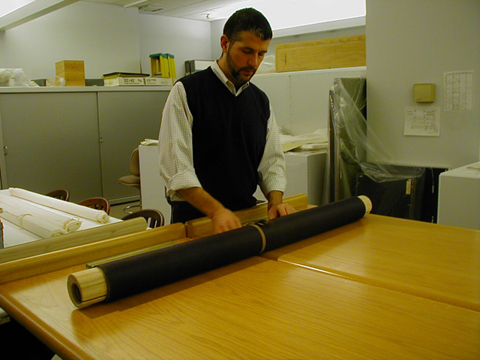 This is Andrew, the Freer’s conservator, a few years ago, testing his new clamp.
This is Andrew, the Freer’s conservator, a few years ago, testing his new clamp.
 And, in my shop, some others, including the longest.
And, in my shop, some others, including the longest.
I used the lathe to turn the legs on the walnut chairs shown above.
-------------------------------------------------------------------
However, I don’t think the concept of wabi sabi is going to cover electronic consumer products. And, I am a fan of those.
I have had cordless phones since they came on the market in the early 80’s. Most memorable is one from about the second generation of those things, years ago. The handset was about as big as a one pound box of spaghetti. After months of use it started to drop calls due to weak signals and weak batteries. It finally got my blood up, and I set it on our brick patio and murdered the base station and the spaghetti box, cutting the two into four pieces with two measured blows of my four pound ax. For three weeks I picked up non-mulching bits of circuit board, plastic, and wire out of the surrounding grass.
And that brings me to the Arabian Nights. Like most people, I was familiar with the Arabian Nights but never read the book. A scene in the 1987 French film Au Revoir Le Enfants got me interested. The film is set in Nazi-occupied France at a boys school and, one night, the boys are huddled in their dormitory, one is reading aloud juicy passages from the Arabian Nights. The film is in French so in the subtitles the boy read: “Truly, she combined the lascivious movements of Arab girls with the consummate science of the Indians, the coquetry of the women of Yemen..” then the scene changed. Wait. Stop. Back up the Tivo. What a great line. What’s the name of that story? Where’s my passport?
With a little internet research I discovered the translation the boys were probably reading was that of Sir Richard Francis Burton, an English scholar. He translated and published a sixteen volume set of the middle eastern folk tales in the late 1800’s.
Here is a link to all 16 volumes. Somewhere in those nearly 6000 pages is that quote. I’m still looking for it. I mention this in the hope that if any of you read some of Burton’s no-holds-barred translations and find it, that you will relay your discovery to me.
http://burtoniana.org/books/1885-Arabian%20Nights/index.htm
If nothing else, I encourage you to read the first few pages of volume one leading up to the introduction of Scheherazade and the beginning of the Thousand and One Nights.
This translation is for adults only. Burton, a bad-boy, prep-school Brit is irreverent, bawdy, and racist by today’s standards, and therefore vastly more entertaining than the milder translations made for more genteel readers. Oh, he was translating the Kama Sutra at the same time.
In the section I have advised you to look at, a king sets out on a journey to see his brother, another king, who is faraway; he leaves his wife behind. The caravan takes so long to get itself together that by the end of the first day’s journey, the group camps for the night still within sight of the castle. The king remembers he forgot something, and returns to his castle to find his wife in the arms of his cook. Enraged “He drew his scimitar and cutting the two in four pieces with a single blow, left them on the carpet and returned presently to his camp……” That wonderful mathematical sentence reminded me of the demise of my second generation cordless phone.
I am presently in search of a scimitar which I plan to have on hand for the next time my aging pc laptop shows me a blue screen filled with indecipherable computer code.
------------------------------------------------------------------- Friday, March 6, 2009, Temperature 68 degrees: Today, typical of the weather in the national capital area, the snow of Monday has returned to nothing.
Winter coats are out of sight. My chair has receded into the back ground, the threatened laptop is stable…. and, a note of caution: the stunt with the ax was performed by a skilled craftsman and is not intended for replication by those without proper training.
All disgarded consumer electronic devices and their batteries should be recycled; most easily through retailers like Radio Shack, Wall Mart, or Office Depot.
--------------------------------------------------------------

--------------------------------------------------------------
links: The Brass Knob http://earth911.com/
http://www.criterion.com/films/549
Posted by ronpaci at 2:32 PM
February 23, 2009
Groceries and green ash
From Ron Paci
Craftsman at large

We ran out of milk today. That means a grocery store run. I’ve been going to the same store since 1986 and have watched the core crew there put on the years.
Today’s run was going to be minor, just the milk and a few other things, probably $45. I closed our white pine front door, featuring twelve small panes of pebbled glass and three clear, gently behind me and walked down our front staircase of seven steps that I re-built with a man-made no-maintenance material called Fiberon; got into my black 1979 Chevy van to make the one-mile trip at 13 miles-to-the-gallon.
I have never walked to the store. My inseam is 29-inches; it takes me 4 steps to cover 8 feet. At that rate it would take a year and a day to get to the store and back. So I drive.
Our street was improved last year with a new surface, small stretches of sidewalk where there was none, and new curbs. It should be one way. Parking is permitted on both sides, and in several places the street is like a narrow bridge over a country stream. We are all very polite, and often it is one of those “go ahead” “no, you go” “no, really, you go ahead” situations. Before the new paving, dirt and stones at the edge of the pavement hit the sheet metal in the wheel wells like hail on a tin roof, when two cars squeezed past each other.
The improvements did not widen the street, but did create official pausing areas. And, it’s very smooth; the sound of the stones is no more.
Left out my driveway, 50 yards, stop at the intersection, and then fresh black surface to the next stop sign just about a quarter mile away. I have driven in anger down my street in my Alfa Romeo; and sped to the end in second gear in an act of defiance on the big Ducati, setting off car alarms with the vibration of its booming exhaust; but not lately.


A block from the end of the street is a towering green ash. The whole of our neighborhood is on a plateau just over 400 feet above the Potomac River. It used to be a dense eastern hardwood forest of massive oaks, ash, walnut, cedar, and beech. Now, of course, it is covered with towering formations of concrete and glass.
The green ash is on a list of ‘notable trees of Arlington’. There are about thirty species of ash. Baseball bats, handles of hammers and shovels are the things that come to most peoples’ minds when ash is mentioned. White ash is the donor for those products.
The green is often sold as white, but there are subtle differences in the grain structure.
Guitar makers like the green, which is slightly paler than the more common white ash and seems to make a better tone.
Trees, as all things in nature, don’t always act the way they are supposed to. The green ash is not known for being particularly large or tall. But the Fraxinus pennsylvanica on my street is a monster.
The European botanists who went about naming the trees they discovered here in the new world named the ash from the Latin word fractus because of the way it breaks or fractures along its annual rings.
When you grip a Louisville slugger baseball bat, the classics made of white ash, and hold it out across the plate, you are to align its logo up or down relative to the ground. It will then hit the ball with the edge of the grain instead of flat on.
If you hit the ball, a wooden bat held correctly will make a beautiful and satisfying sound.

If you hit the ball with the logo side the bat may fracture. Either way, at least it won't make the hit with a loud aluminum pole 'ping.'
The early botanists also used the place of discovery in the naming of some plants.

From the ground up to four feet the trunk of this wooden neighbor is about 30-inches thick. At that point it splits into two long trunks about 24-inches in diameter.
Shooting skyward, the tops blossom into one great round fourth-of-July crown.
I try to stop and gaze at it every season, and pat it on its trunk. It’s the first to announce the arrival of fall when its leaves turn yellow.
I don’t know how old it is.
Scientists estimate the average life span of a green ash is one to two hundred years, but since mine has broken out of the mold with its height, I like to think it is ageless as well, the shade from its young crown protecting an Algonquian brave sitting, back against the trunk, on a hot August day, whittling a bow of green ash, and contemplating the death of the three sisters of his tribe.
The three sisters, Native American legend has it, drowned in the Potomac on a mission of revenge against the Susquehannocks the annoying tribe who controlled the northern side of the river and had killed the boys who were to be the girl's husbands. Captain John Smith wrote the Susquehannocks he met in the first years of the 1600’s ‘seemed as giants…..great and well proportioned,” and warlike.
The river separated the two tribes.
A storm hit as the three young girls crossed from the south on a raft. Unable to fight the raging river, they were swept downstream. And, being daughters of an Algonquian shaman, when they saw their fate was sealed, they uttered a curse: if they couldn’t cross the river here, then no one else would, ever.
They drowned, the storm passed, and three boulders appeared above the surface where before there had been none. The boulders have been known ever since as Three Sisters Island. All future attempts to build a bridge over the islands have been foiled. The river here is forty feet deep. The last failed attempt at a bridge here was in 1972.

I also think about the fear of nature when I pass this green ash.
Suburban types are fearful of tall trees. The big guys get cut down on the pretense of too many leaves to clean up, or it’s going to fall on me (the sky is falling, the sky is falling); though sometimes it is going to fall on you.
Or, they attract too many insects, like the box elder next to our house that attracts hoards of box elder bugs. They walk about safely inside our residence.
Or, the roots are going to damage our precious property. Nearby, an original oak, with a 40-inch trunk was criminally sacrificed for the construction of a tasteless McMansion, the builder, hopefully, going totally bankrupt. I counted 158 rings on its butchered stump.
When they get around to cutting down the green ash that will be my signal to leave.
At the end of my street, the route to the grocery store requires a left hand turn across a four-lane suburban street; a maneuver of increasing difficulty caused by increasing traffic here in Arlington where there are more than 8,000 people per-square-mile.
Feeding into the lane I have to cross is a pair of two-lane streets controlled by dueling traffic signals. At rush hour even I can’t get across unless I pull my death-defying trick of pitching one of my irreplaceable machines into an iffy gap in the flow and forcing more reasonable and level-headed drivers to stop and let me through; once I have them stopped, I crawl into the next lane and let them pass by, rolling their eyes and honking their horns. I try to wait for drivers with a lot to lose. Like a Mercedes driver. No one has actually gotten out of their car and come at me. Though, it could happen.
I only do that when I’m in the proper frame of mind. Otherwise, I use alternate routes.
Today, that intersection provided little resistance. I turned left, and continued two blocks to another traffic signal. Straight ahead is the unmarked office building containing DARPA, The Defense Advanced Research Projects Administration.
They invented the internet, regardless of what Al Gore claims.
The building is guarded 24-hours a day by one manned county patrol car, one manned unmarked car, and a guard on the street with a sidearm.
And, in the lobby, a corporal with a flame-thrower in case Anthony Quinn, dressed as a Howeitat Bedouin, rides his camel off the screen of Lawrence of Arabia and into the lobby to inflict punishment onto the infidels.
But I’m not going past DARPA, I’m turning right here at this light where the FDIC building dominates the landscape. My buddy Jonas works here. Jonas got a junk mailing once addressed to Joe Nas.
Another block and right turn into the grocery store parking lot designed for the maximum number of cars and the minimum amount of space for getting into and out of the parking slots.
A traffic-clogged highway imposes a restriction on your speed, this tight parking lot imposes a degree of extra caution on all who enter. I have never seen an accident in the lot. Everybody tiptoes.
The grocery store chain is owned by a Dutch company, a fact that I considered curious and unusual, until recently when it occurred to me that maybe the Dutch are plotting to expand their empire once again like they did in the 1600’s when the Dutch East India Company was chartered to buy up the American coast.
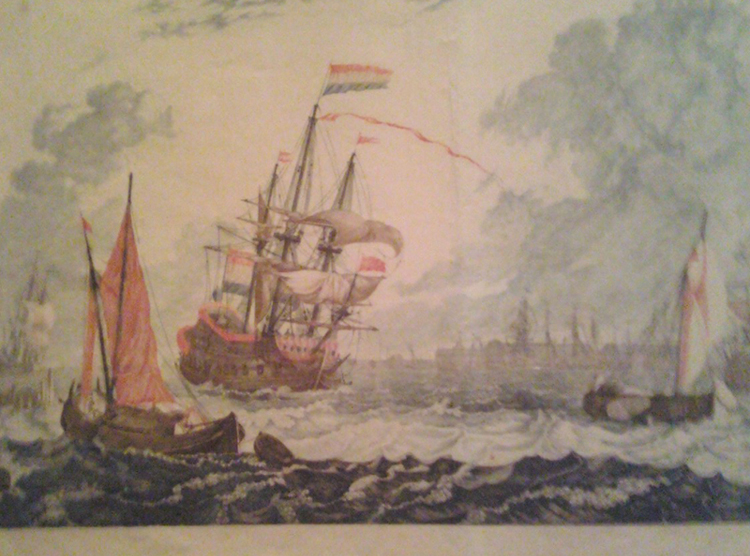
Dutch ship, National Gallery, clandestine phone shot
They just remodeled this store, which sits on land owned by the FDIC, i.e. The United States Government. There is a conflict there somewhere with the Dutch owning a franchise on U.S. government property, but I don’t know what it is.
Another thing I don’t know is where any thing is inside. They relocated almost everything. Being a closet codger, I’m careful not to complain. Same thinking when I keep my mouth shut when the conversation turns to television programs like Howdy Doody, The Lone Ranger, The Cisco Kid, and Sea Hunt.
‘Nope, never heard of Buffalo Bob Smith, Clayton Moore, Duncan Renaldo, or Lloyd Bridges. Don’t know what you’re talking about. Before my time.”
I have watched the years accumulate on several people here over the past quarter century of visiting this store, yet they seem to be fresh out of high school, self-absorbed, self-conscious, eager to do right; salt of the earth, hard-working folks. I’m afraid to ask them where they’re from for fear they will say the small town where I grew up 200 miles to the north.
'The riverboat gambler,' just under six-feet, stocky build, in his fifties, with a two-inch band of hair right around the middle of his orb, finishing in a three-inch long braided pony tail in the back, about as big as four shoe laces woven together. His impish character shows through, despite his efforts.
At Christmas he wears a Santa hat, at Halloween a mask. He advertises his family with photos on his cash register. Parked next to it is a Christian icon. Outwardly, he is always nice, polite, and always has a good word, anxious to engage the endless stream with some small superficial human contact. But, to me, he projects “Si’down gents, what’ll it be? Five-card stud?”
'The merry prom queen' was probably a beauty on her high school class picture, probably the same year as mine. Now in her declining years, she works the register or does chores around the store with a smile on the outside. But, her eyes say, “I’m so weary.” She too is eager to engage any who would say a word. She must have back pain, because often I see her walking around dramatically with her hand on the back of her waist, and eyes that challenge and invite any and all to ask “How you doin’ today?” She projects a would-be friend-in-pain to all.
'The comb-over guy' is bald on top, but he has let the hair above his left ear grow to about ten inches long, which he then carries up and over. He seems to be very self-conscious. He's tall, and lanky; in his fifties; his arms seem extra long, and an uncooperative shirttail often troubles him. He often seems to be looking into the distance for something, perhaps approval; he too is dutiful, eager to help.
'The tired old gal' is probably the oldest of the bunch; always forlorn, the weight of the world on her hunched back. Her hair has been gray for ages and it’s probably only the love of her family that gets her out of bed. I see her in the morning sometimes proudly pushing a trolley of cartons down the aisles saying with her stride “You can’t get rid of me yet. Look at me push this cart.” Though when I see her doing things like that I worry that she is going to collapse into a worrisome heap. I resist my urge to say 'Here, let me drive that thing for you."
They all seem to have a strength of character, that I lack, which allows them to cheerfully face the endless parade day after day. Though, I have noticed, they are more chipper early in the morning than later in the day.
I’m supposed to wear a hat to protect my pate from the sun. I do that. Today I wore my black L.L. Bean pull-over fleece with the collar turned up, and my Canyonlands hat purchased for me by my loving wife. In the store I always try to be invisible; a pair of eyes searching for English muffins.

That’s a trick I practice with only partial success. I passed a pretty mother and her thirtyish daughter near the lettuce. The mother, gray hair and fair of face, smiled at me, as I was slow to look away. The younger fair of face saw only lettuce.
The Dutchmen introduced four self-scanning checkout stations, which I welcomed with open arms and used today. The scanners will allow me to avoid any human contact whatsoever, as I do at Home Depot. But the design isn’t quite right. The platform for scanned items is the same size as the Depot, but seems too small for the tumbling collection of groceries. It’s always something. I will adjust. These first generation checkout machines are no threat, yet, to my characters.
$46.37 into the back of the van, left out of the parking lot, past the FDIC, to the light.
Decision time.
Straight? Five blocks through the neighborhood, turn right, then after four blocks, left.
Left? Two blocks, turn right, then straight five blocks to the starting point.
Or, right? 49 hours rolling time to the Pacific Ocean.
 Right, or left?
Right, or left?
I got the milk.
Posted by ronpaci at 10:07 PM
November 24, 2008
life in a workshop

DAY ONE: Monday, Nov. 24: These three pieces of furniture-in-the-making represent the third of three jobs I received deposits on in early July.
The first was the restoration of 21 antiques damaged in a flooded condo: 2 chests of drawers, a dining table, 8 chairs,various small tables and more; 84 days of continuous work. I finished around the first week of October, and the client moved back in happy with all her furniture.

The second job, for a former client, was to make an armoire similar to this antique I restored for her two years ago. Can I finish it by the end of the year?
I moved away from the job at hand - the three pieces at the top - several times due to 'jobs of opportunity', that is jobs that require mainly doing rather than thinking and doing, and I was saving it for when I had a clear mind and money in the bank.
The photo below is a mock-up of what are to be two nightstands for the client's master bedroom. The knob is temporarily held in place.
The logic-defying black desk with one leg is for the guest bedroom of the same client.

The desk is made of oak which has been coerced into becoming black with a black dye-stain, followed by black oil-stain. The clear finish over the two stains produced a really nice satin sheen; like polished slate. There isn't any paint on it.

Below: the sycamore drawer and the hand-carved foot is oak.
The design is my version of an Italian 'moderne' piece from the 1950's.
I'm almost finished with it.

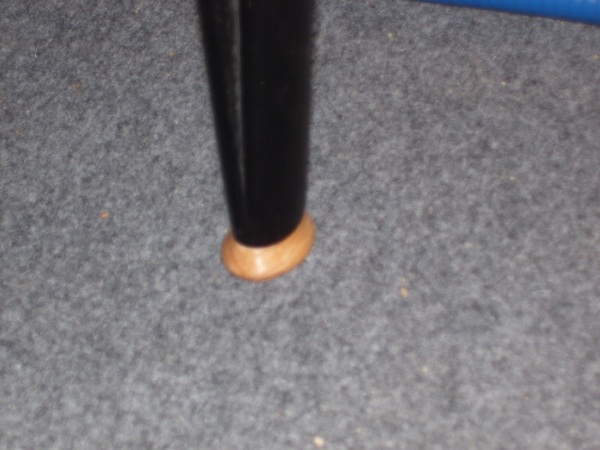
THE NIGHTSTANDS
The nightstands will have a drawer, and a shelf below. The veneer is French walnut. They are companion pieces to this antique chest of drawers also of French walnut.

The top is a book-match of four pieces of veneer with a border of more French walnut outlined with ebony strips.

French walnut lumber was unavailable locally, and it took a trip, in late July, to a Pennsylvania importer to find a suitable board for the legs. The $300 board I bought had just enough material to get the right grain pattern and color for the front two legs of each table; the back legs got the less attractive grain pattern. I had to cut and paste to get the thicker dimension.
What I was after was solid wood to make the curved shape on the fronts.

The pieces are coming together now. I was just getting a grip on them the first of November when I got an offer I couldn't refuse. That job gutted the month.
I like to get projects like this to a more fully developed stage before I go all-ahead-full. A call today from one of the twisted knickers involved asked my favorite questions: "When is it going to be done?" "Why is it taking so long?"
So I'm moving the lever all the way forward.
Today, at the end of eight hours I have the black desk just about finished. The nightstands are fleshed out; not sure how much time I have in them to date; call it four days, including the eight hours for the Pennsylvania trip.
So let's just see how long it takes to go from here to completion.......
TUESDAY
Noon: Three hours to finish off the drawer and other details on the black desk. It's ready to go.
In projects like this for every problem solved new problems come up.
I managed to find the hardwood for the legs, but I didn't buy enough. Now the sides of the legs show an unattractive line where material has been glued up. I'm going to have to veneer the sides of the legs.
And the backs of the rear legs are visible from the front. At least two of those are going to require veneering to cover some unattractive grain swirls.
That task chewed up the day.
Ten hour day.
WEDNESDAY
Started early; ran the strip of ebony along the bottoms of the sides; made the dovetailed drawer parts; finished veneering the legs.
This job is technically being done out of turn, and it is in
violation of a ronpacifinewoodworkiing rule established in
1983: which states that ronpaci does not work through a middle
man and direct contact with the client is mandatory.
I have not met the client for this job. This is a problem. Clients have to fit my approved profile. They have to be vetted for their ability to withstand the ways and means of ronpacifinewoodworking.
I was busy when this came in. I put in a healthy bid, they agreed, and I let it go.
So here I am, the best fine woodworking effort of the year going to a stranger.
Veneered the bottom of the tops with two wide sheets of maple veneer. Both sides of a panel need to be veneered so it stays flat.
Eight hour day.
THURSDAY
Thanksgiving. Started late.
I've been in total isolation since Monday evening. The land line is on 'do not disturb', cell phone is turned off, in a pocket somewhere; wife is content, reading and nursing a cold; grandkids are with the other grandparents.
The sky is gun-metal grey. The shop is warm and the sound of Radio Olgiata is being broadcast from Rome through my pocket pc and out the speakers powered by two 12-volt marine batteries being lightly charged by one lonely 50-watt solar panel on the roof of my 1924 wood garage which will probably collapse under it's own weight in about 25 years just like me.
I'm working on the tops. They are an inch thick, two pieces of half-inch thick Baltic birch, glued together so the slight bow in the panels cancels itself out.
I did that and laid the book-matched centers on both tops last month.
Today I'm routing a groove around the main veneer; just over a sixteenth inch deep and exactly a sixteeth inch wide using the outside edge of the top as a guide.
- rip strips of ebony from a larger board on the bandsaw
- machine strips with a drum sander to fit into the groove
- cut 8 strips to length
- block sand ends to 22.5 degrees
- run glue into groove using a plastic hyperdermic device
- hammer strips into groove
- repeat for other top
The strips are oversize and stand proud to the surface making an edge to push against with the narrow pieces that make the border of french walnut.
The veneer for the border has a straight grain pattern in contrast to the broad grain pattern in the middle.
The color varies from plain orangy-brown to an area with black grain. The black in the wood is the premier feature of French walnut. The eboniste of Louis XIV loved it.

Laying the border starts at the centerline of the main four pieces on the top. I used the plainer area as the starting point, and tried to keep it logical as the pieces approached the corners.
I cut the strips with my new, specially sharpened, German veneer saw. I probably should have used my French veneer saw, but it's seen quite a bit of action.
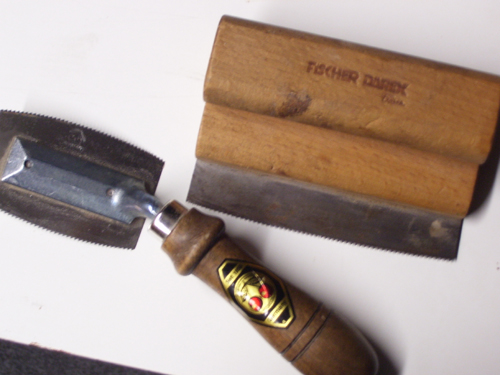
- repeat steps for other top
I did some other things related to the drawers.
Turned out the lights at 11.
Twelve hour day.
FRIDAY
The thin ebony strip laid into the top is still proud of the
veneer on either side. I scraped it flat with a piece of steel
with a special edge... called a cabinet scraper, appropriately
enough. A very controlled way to remove material, unlike
indiscriminate power sanding.
Now with the router, I cut away the edge and glued on the ebony
border using tape stretched over the edge as a clamp to hold the strip in place.
Another 16 pieces.
- when dry, scrape flat
- sand all...carefully.
The veneer and inlay work is complete on the tops; each one has 64 bits of material.

It warmed up a little today, so I sprayed finish on the tops, sides, and legs. Now we're getting somewhere.
I prepared a table for the assembly. That will be the step of commitment.
Ten hour day.
SATURDAY, SUNDAY, MONDAY
Work, eat, sleep....a friend calls me a binge worker, with the implication of being obsessive, in the psychologically imbalanced sense.
But, I think craftspeople and artists get a pass on that. It takes a state of mind to do fine work. And small objects, like the ones I'm working on, demand greater attention to detail. Ringing phones, social lunches, inquiring minds, any intrusion knocks you off the tightrope.
Every mistake I make I can attribute to my mind drifting away from what my hands are doing. Like dropping a glass in the sink, immediate reflection will show you were thinking about something other than the glass and the sink.
I knocked a leg off my assembly table resulting in two dents, right on the front. Mind drift; thinking about some wisecrack to make to my decorator friend and the client.
Dents in wood can be magically steamed out with a hot iron and a wet paper towel.
Monday night: 8 days of concentrated effort. It took three 10-hour days to get a coat of finish on the parts, glue the legs to the sides, fit the bracing, make the panel under the drawer, and fix problems.

TUESDAY
Spent the day on the two shelves: Final fitting of the panels, applying the veneer with the dark stripe in the center to relate to the pattern on the top, gluing on the ebony edge, and spraying the finish.
I stopped at 6. I noticed my attention span was now depleted.
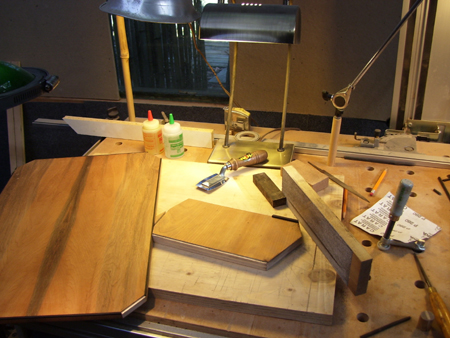
WEDNESDAY
Now approaching 100 hours on the two nightstands; I pulled the plug at 5:30, but went back at 7 and finished everything except the drawer fronts, fitting the drawers, and attaching the tops.
Ten days would have been a nice round number, but I'll settle for eleven.
THURSDAY
I couldn't decide on how to fit the drawer fronts to the legs which are set at a 45 degree angle. Under consideration was to cut a pocket into the top of the legs and have the drawer front with a normal square edge fit into the cutout area.
That would be a risky operation at this point, even though I knew how I was going to carry it off.
I had glued hardwood to the sides of the drawer fronts for this purpose.
In the end I cut the sides of the drawer fronts at 45 degrees to match the legs. But I left a small area at 90 degrees so it wouldn't create a knife edge, and to protect the veneer.
Here it is finished with a cherry veneer bottom:

I used the same veneer for the fronts and sides, and for the edges of the tops and shelves; always starting from the center and working out. The effect is the pattern reads vertically through all the parts.
The pattern on the top stands alone, unrelated to the rest.

THREE P.M. I stepped back for the first time, the last screw in place. The hours added up to exactly 100, counting Monday Nov. 24.
I can think of several more things that could be done; I can think of several things I would like to do over...basta, finito.

The exact flow of events for Saturday through Sunday is lost. I should have kept a record of what I did each day; though I did note the time.
One of the things that goes through my mind when I burn time like this is that at least there will be physical evidence of my effort.
The owner of the twisted knickers who found herself between the client and me came to see the 'finished' pieces. There were squeals of delight, hugging, photographs, and happiness. Knickers were tidied up.
After she had gone, I moved the three pieces to the back of the shop and covered them. They sat there for four days out of my sight, at least.
Delivery was the following Tuesday Dec. 9. The first thing we did after the nightstands were placed beside the client's bed was to set two giant lamps on them covering the main feature of the tops. They went to work.

They were a nice complement to the antique chest of drawers:

The black desk worked perfectly in the space, though kind of dwarfed by the big art. We are looking for a suitable bench to go with it.

It was reported that the client 'absolutely loved everything....it felt like Christmas,' she said.
And, I might add, how about that timely pre-holiday delivery.
Posted by ronpaci at 7:12 PM
October 20, 2008
Columbus Day 2008

Monday morning, 6:45 am Debo and I are on the metro rushing to 1600 Pennsylvania Ave. Key streets downtown are blocked off; Silvio Berlusconi, the Italian prime minister, is here; plus the World Bank and the International Monetary Fund are having their annual meetings.
Off the metro at 7, two blocks north of 1600. Traffic’s jammed in all directions; dark suits and shiny shoes everywhere.
The back of my right foot is working up a blister from a new Rockport.
I have in the pocket of my 20-year-old sports coat two gold-embossed tickets for admission to the White House grounds - two more bodies in the crowd for the presidential greeting ceremony for Silvio Berlusconi.
Appropriately, it's Columbus Day. There will be one other craftsman of Italian heritage in the crowd that I know. Our tickets came to us thru a friend we have in common at the State Department.
The feeling of actually being part of the official scene here is of course a big departure from both of our morning routines: Debo lying in bed reading the paper to her dog and surfing the internet; me walking around in a fog trying to decide what flavor of sawdust I’m going to make.
We walked past the front of the White House and turned onto 17th street to the west entrance of the White House grounds. I know enough now not to carry my German switchblade on occasions like this, so we sailed through the security scanner with just coins and cameras and emerged onto the south lawn of the presidential mansion. People in the growing crowd were speaking Italian. That always perks me up.
The audience is split into two roped off viewing areas, east and west, on either side of the podium, which sits on a red carpet.

We were in the west area. Facing east, the White House is on our left. Over that shoulder is the rose garden and the west wing portico with the oval office at the end. The trees are labeled. There is a silver linden still with green leaves. It might be worth being president just to live here; there is a little putting green. It is very pleasant.
To our right in the distance across Constitution Avenue is the Washington Monument. On the White House side of that avenue is the placement of the cannon for the morning's 19-gun salute specified for prime ministers. I hear these salutes from our home in Arlington; on this day I saw the smoke.

They opened the gates at 7, we got there around 7:20, and after another 10 minutes of walking around dazed in these famous but generally inaccessible grounds we realized the crowd at the rope was now 4 heads deep and we missed the best view.
The grass is about 3-inches tall and wet. I feel a limp coming on from my new shoe blister. I’m wishing I had spent Sunday getting a haircut instead of buying new shoes.
The color guard from all the service branches came in: stern faces and clicking heals. Bob Tomallo, a grade school classmate used to do these ceremonies when he was in the Marine color guard 40 years ago.
Now the shouted commands have an occasional female voice. I smile to myself recalling the old timers at the newspaper where I once worked cynically proclaiming 'who let these women into the newsroom???"
With the military units and band in place, the Old Guard Fife and Drum Corp. marched in. The band played several familiar tunes which I can no longer name.
Finally the limos arrived: Cheney, Condi, ambassadors; Berlusconi limoed from the Blair house across the street. I wonder if he admired the mahogany and verde marble menu stand I made for the Blair House dining room?

The trumpets sounded and W and Laura walked out of the White House.

Silvio and Bush inspected the troops. They passed right by us; I got a lame photo with camera held overhead. We listened to the speeches from our remote positions. Italian translated to English. English translated to Italian. I caught a few words.
Burlusconi spoke of the time his father took him to a cemetery in
Rome where a number of American WWII soldiers were buried. He said his father told him it was because of the sacrifice of those buried here that he is free today and able to go to a great school in Rome.
He said Italy will always be a friend to America.
He's a charmer. I damn near cried.

Cheney, known as Satan by some people I know, and Condi sat right in front of our section's rope. We were four heads back; we didn't know they were there at the time. Good thing, my wife is kind of volatile, certain things set her off.
One gets jaded living here. I have watched the July fourth fireworks live on TV when I could have seen them by walking a few blocks to a line of sight in my neighborhood.
It was beautiful sunny day, and warm, so I didn't need the formal overcoat that I don't own.
I was getting a heady feeling being present at what seemed like the big event in town today, amidst invitation-only guests on the grounds of the most famous address in the world, spitting distance from the top three people in the government, and the president of the United States of America welcoming the prime minister of the great country of Italy...
And my wife is chanting from the back of the crowd at a half whisper: Obama...Obama...Obama....

Posted by ronpaci at 10:31 PM


